項目架構圖
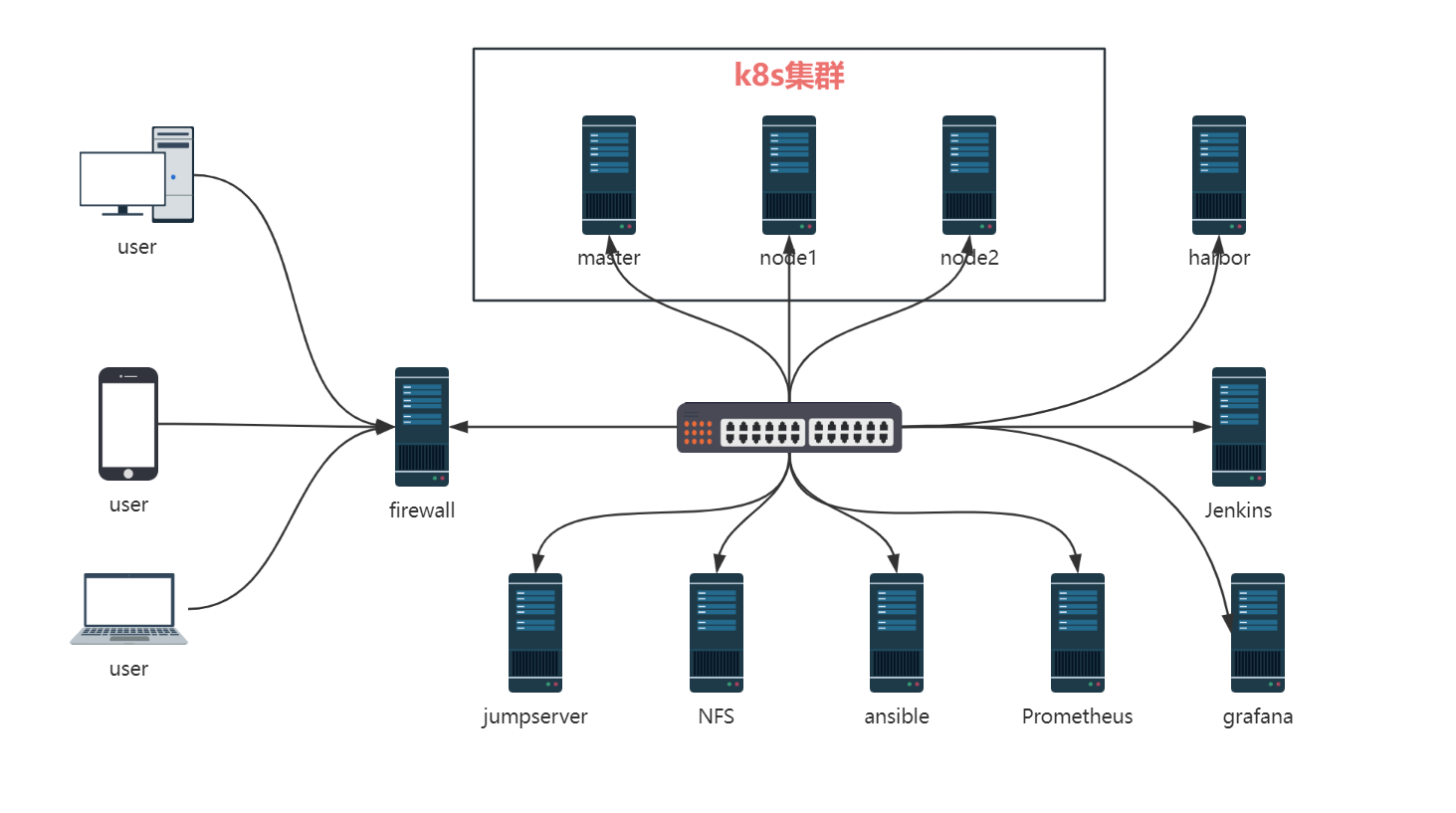
| server | ip |
| master | 192.168.140.130 |
| node1 | 192.168.140.131 |
| node2 | 192.168.140.132 |
| ansible | 192.168.140.166 |
| jumpserver | 192.168.100.133 |
| firewall | 192.168.1.86 |
| nfs | 192.168.140.157 |
| harbor | 192.168.140.159 |
| Promethethus | 192.168.140.130 |
| Jenkins | 192.168.140.130 |
| Grafana | 192.168.140.130 |
| Dashboard | 192.168.140.130 |
項目描述
本項目旨在模擬公司生產環境,構建一個高性能、高可用的 Kubernetes(K8s)集群,用于部署和管理 Web 應用、MySQL 數據庫、NFS 存儲服務、Harbor 私有鏡像倉庫、Prometheus 監控系統以及 Jenkins 持續集成工具。通過整合這些關鍵組件,實現應用的高效部署、自動化運維、性能監控和數據持久化,為企業的數字化轉型提供堅實的技術支撐。
項目的核心目標是打造一個穩定、可靠的云原生平臺,支持 Web 應用的快速迭代和彈性擴展,同時確保數據的安全性和一致性。通過 Kubernetes 的容器編排能力,結合 Prometheus 和 Grafana 的監控可視化功能,以及 Jenkins 的 CI/CD 流水線,實現從代碼開發到生產部署的全流程自動化。此外,Harbor 鏡像倉庫的引入,進一步優化了鏡像管理流程,提高了鏡像分發的效率和安全性。
通過本項目的實施,不僅能夠提升開發和運維團隊的工作效率,還能夠顯著降低運維成本,增強系統的整體可靠性,為企業的業務發展提供有力保障。
項目環境
CentOS7.9,kubelet-1.23.17,docker-ce-20.10.6,jumpserver,nfs,Jenkins,harbor2.8.3,prometheus-2.43.0,dashboard,Grafana9.1.2-1,mysql等
修改主機名
hostnamectl set-hostname master
hostnamectl set-hostname node1
hostnamectl set-hostname node2#切換用戶,重新加載環境
su - root
[root@master ~]#
[root@node1 ~]#
[root@node2 ~]#關閉selinux和firewall
# 防火墻并且設置防火墻開啟不啟動
service firewalld stop && systemctl disable firewalld# 臨時關閉seLinux
setenforce 0# 永久關閉seLinux
sed -i 's/SELINUX=enforcing/SELINUX=disabled/g' /etc/selinux/config[root@master ~]# service firewalld stop
Redirecting to /bin/systemctl stop firewalld.service
[root@master ~]# systemctl disable firewalld
[root@master ~]# sed -i 's/SELINUX=enforcing/SELINUX=disabled/g' /etc/selinux/config
[root@master ~]# reboot
[root@master ~]# getenforce
Disabled配置靜態ip地址
#master節點
[root@master ~]# cd /etc/sysconfig/network-scripts/
[root@master network-scripts]# vim ifcfg-ens33BOOTPROTO="none"
NAME="ens33"
DEVICE="ens33"
ONBOOT="yes"
IPADDR=192.168.140.130
#NETMASK=255.255.255.0
PREFIX=24
GATEWAY=192.168.140.2
DNS1=114.114.114.114#node1節點
[root@node1 ~]# cd /etc/sysconfig/network-scripts/
[root@node1 network-scripts]# vim ifcfg-ens33BOOTPROTO="none"
NAME="ens33"
DEVICE="ens33"
ONBOOT="yes"
IPADDR=192.168.140.131
#NETMASK=255.255.255.0
PREFIX=24
GATEWAY=192.168.140.2
DNS1=114.114.114.114#node2節點
[root@node2 ~]# cd /etc/sysconfig/network-scripts/
[root@node2 network-scripts]# vim ifcfg-ens33BOOTPROTO="none"
NAME="ens33"
DEVICE="ens33"
ONBOOT="yes"
IPADDR=192.168.140.132
#NETMASK=255.255.255.0
PREFIX=24
GATEWAY=192.168.140.2
DNS1=114.114.114.114添加hosts域名解析
[root@master ~]# vim /etc/hosts
[root@master ~]# cat /etc/hosts
127.0.0.1 localhost localhost.localdomain localhost4 localhost4.localdomain4
::1 localhost localhost.localdomain localhost6 localhost6.localdomain6
192.168.140.130 master
192.168.140.131 node1
192.168.140.132 node2項目步驟
一、安裝部署k8s單master的集群環境(1個master+2個node節點)
# 1.互相之間建立免密通道
ssh-keygen # 一路回車ssh-copy-id master
ssh-copy-id node1
ssh-copy-id node2# 2.關閉交換分區(Kubeadm初始化的時候會檢測)
# 臨時關閉:swapoff -a
# 永久關閉:注釋swap掛載,給swap這行開頭加一下注釋
[root@master ~]# cat /etc/fstab#
# /etc/fstab
# Created by anaconda on Thu Mar 23 15:22:20 2023
#
# Accessible filesystems, by reference, are maintained under '/dev/disk'
# See man pages fstab(5), findfs(8), mount(8) and/or blkid(8) for more info
#
/dev/mapper/centos-root / xfs defaults 0 0
UUID=00236222-82bd-4c15-9c97-e55643144ff3 /boot xfs defaults 0 0
/dev/mapper/centos-home /home xfs defaults 0 0
#/dev/mapper/centos-swap swap swap defaults 0 0# 3.加載相關內核模塊
modprobe br_netfilterecho "modprobe br_netfilter" >> /etc/profilecat > /etc/sysctl.d/k8s.conf <<EOF
net.bridge.bridge-nf-call-ip6tables = 1
net.bridge.bridge-nf-call-iptables = 1
net.ipv4.ip_forward = 1
EOF#重新加載,使配置生效
sysctl -p /etc/sysctl.d/k8s.conf# 為什么要執行modprobe br_netfilter?
# "modprobe br_netfilter"命令用于在Linux系統中加載br_netfilter內核模塊。這個模塊是Linux內# 核中的一個網絡橋接模塊,它允許管理員使用iptables等工具對橋接到同一網卡的流量進行過濾和管理。
# 因為要使用Linux系統作為路由器或防火墻,并且需要對來自不同網卡的數據包進行過濾、轉發或NAT操作。# 為什么要開啟net.ipv4.ip_forward = 1參數?
# 要讓Linux系統具有路由轉發功能,需要配置一個Linux的內核參數net.ipv4.ip_forward。這個參數指# 定了Linux系統當前對路由轉發功能的支持情況;其值為0時表示禁止進行IP轉發;如果是1,則說明IP轉發# 功能已經打開。# 4.配置阿里云的repo源
yum install -y yum-utils
yum-config-manager --add-repo http://mirrors.aliyun.com/docker-ce/linux/centos/docker-ce.repoyum install -y yum-utils device-mapper-persistent-data lvm2 wget net-tools nfs-utils lrzsz gcc gcc-c++ make cmake libxml2-devel openssl-devel curl curl-devel unzip sudo ntp libaio-devel wget vim ncurses-devel autoconf automake zlib-devel python-devel epel-release openssh-server socat ipvsadm conntrack ntpdate telnet ipvsadm# 5.配置安裝k8s組件需要的阿里云的repo源
[root@master ~]# vim /etc/yum.repos.d/kubernetes.repo
[kubernetes]
name=Kubernetes
baseurl=https://mirrors.aliyun.com/kubernetes/yum/repos/kubernetes-el7-x86_64/
enabled=1
gpgcheck=0# 6.配置時間同步
[root@master ~]# crontab -e
* */1 * * * /usr/sbin/ntpdate cn.pool.ntp.org#重啟crond服務
[root@master ~]# service crond restart# 7.安裝docker服務
yum install docker-ce-20.10.6 -y# 啟動docker,設置開機自啟
systemctl start docker && systemctl enable docker.service# 8.配置docker鏡像加速器和驅動
vim /etc/docker/daemon.json {"registry-mirrors":["https://rsbud4vc.mirror.aliyuncs.com","https://registry.docker-cn.com","https://docker.mirrors.ustc.edu.cn","https://dockerhub.azk8s.cn","http://hub-mirror.c.163.com"],"exec-opts": ["native.cgroupdriver=systemd"]
} # 重新加載配置,重啟docker服務
systemctl daemon-reload && systemctl restart docker# 9.安裝初始化k8s需要的軟件包
yum install -y kubelet-1.23.17 kubeadm-1.23.17 kubectl-1.23.17# 設置kubelet開機啟動
systemctl enable kubelet #注:每個軟件包的作用
#Kubeadm: kubeadm是一個工具,用來初始化k8s集群的
#kubelet: 安裝在集群所有節點上,用于啟動Pod的
#kubectl: 通過kubectl可以部署和管理應用,查看各種資源,創建、刪除和更新各種組件# 10.kubeadm初始化k8s集群
# 把初始化k8s集群需要的離線鏡像包上傳到k8smaster、k8snode1、k8snode2機器上,然后解壓
docker load -i k8simage-1-20-6.tar.gz# 把文件遠程拷貝到node節點
root@k8smaster ~]# scp k8simage-1-20-6.tar.gz root@node1:/root
root@k8smaster ~]# scp k8simage-1-20-6.tar.gz root@node2:/root# 查看鏡像
[root@node1 ~]# docker images
REPOSITORY TAG IMAGE ID CREATED SIZE
registry.aliyuncs.com/google_containers/kube-proxy v1.20.6 9a1ebfd8124d 2 years ago 118MB
registry.aliyuncs.com/google_containers/kube-scheduler v1.20.6 b93ab2ec4475 2 years ago 47.3MB
registry.aliyuncs.com/google_containers/kube-controller-manager v1.20.6 560dd11d4550 2 years ago 116MB
registry.aliyuncs.com/google_containers/kube-apiserver v1.20.6 b05d611c1af9 2 years ago 122MB
calico/pod2daemon-flexvol v3.18.0 2a22066e9588 2 years ago 21.7MB
calico/node v3.18.0 5a7c4970fbc2 2 years ago 172MB
calico/cni v3.18.0 727de170e4ce 2 years ago 131MB
calico/kube-controllers v3.18.0 9a154323fbf7 2 years ago 53.4MB
registry.aliyuncs.com/google_containers/etcd 3.4.13-0 0369cf4303ff 2 years ago 253MB
registry.aliyuncs.com/google_containers/coredns 1.7.0 bfe3a36ebd25 3 years ago 45.2MB
registry.aliyuncs.com/google_containers/pause 3.2 80d28bedfe5d 3 years ago 683kB# 11.使用kubeadm初始化k8s集群
kubeadm config print init-defaults > kubeadm.yaml[root@master ~]# vim kubeadm.yaml
apiVersion: kubeadm.k8s.io/v1beta2
bootstrapTokens:
- groups:- system:bootstrappers:kubeadm:default-node-tokentoken: abcdef.0123456789abcdefttl: 24h0m0susages:- signing- authentication
kind: InitConfiguration
localAPIEndpoint:advertiseAddress: 192.168.2.104 #控制節點的ipbindPort: 6443
nodeRegistration:criSocket: /var/run/dockershim.sockname: k8smaster #控制節點主機名taints:- effect: NoSchedulekey: node-role.kubernetes.io/master
---
apiServer:timeoutForControlPlane: 4m0s
apiVersion: kubeadm.k8s.io/v1beta2
certificatesDir: /etc/kubernetes/pki
clusterName: kubernetes
controllerManager: {}
dns:type: CoreDNS
etcd:local:dataDir: /var/lib/etcd
imageRepository: registry.aliyuncs.com/google_containers # 需要修改為阿里云的倉庫
kind: ClusterConfiguration
kubernetesVersion: v1.20.6
networking:dnsDomain: cluster.localserviceSubnet: 10.96.0.0/12podSubnet: 10.244.0.0/16 #指定pod網段,需要新增加這個
scheduler: {}
#追加如下幾行
---
apiVersion: kubeproxy.config.k8s.io/v1alpha1
kind: KubeProxyConfiguration
mode: ipvs
---
apiVersion: kubelet.config.k8s.io/v1beta1
kind: KubeletConfiguration
cgroupDriver: systemd# 12.基于kubeadm.yaml文件初始化k8s
[root@k8smaster ~]# kubeadm init --config=kubeadm.yaml --ignore-preflight-errors=SystemVerificationmkdir -p $HOME/.kube
sudo cp -i /etc/kubernetes/admin.conf $HOME/.kube/config
sudo chown $(id -u):$(id -g) $HOME/.kube/configkubeadm join 192.168.2.104:6443 --token abcdef.0123456789abcdef \--discovery-token-ca-cert-hash sha256:83421a7d1baa62269508259b33e6563e45fbeb9139a9c214cbe9fc107f07cb4c # 13.擴容k8s集群-添加工作節點
[root@k8snode1 ~]# kubeadm join 192.168.2.104:6443 --token abcdef.0123456789abcdef \--discovery-token-ca-cert-hash sha256:83421a7d1baa62269508259b33e6563e45fbeb9139a9c214cbe9fc107f07cb4c [root@k8snode2 ~]# kubeadm join 192.168.2.104:6443 --token abcdef.0123456789abcdef \--discovery-token-ca-cert-hash sha256:83421a7d1baa62269508259b33e6563e45fbeb9139a9c214cbe9fc107f07cb4c # 14.在master上查看集群節點狀況
[root@master ~]# kubectl get nodes
NAME STATUS ROLES AGE VERSION
master NotReady control-plane,master 2m49s v1.20.6
node1 NotReady <none> 19s v1.20.6
node2 NotReady <none> 14s v1.20.6# 15.node1,node2的ROLES角色為空,<none>就表示這個節點是工作節點。
可以把node1,node2的ROLES變成work
[root@master ~]# kubectl label node node1 node-role.kubernetes.io/worker=worker
node/node1 labeled[root@master ~]# kubectl label node node2 node-role.kubernetes.io/worker=worker
node/node2 labeled
[root@master ~]# kubectl get nodes
NAME STATUS ROLES AGE VERSION
master NotReady control-plane,master 2m43s v1.20.6
node1 NotReady worker 2m15s v1.20.6
node2 NotReady worker 2m11s v1.20.6
# 注意:上面狀態都是NotReady狀態,說明沒有安裝網絡插件# 16.安裝kubernetes網絡組件-Calico
# 上傳calico.yaml到master上,使用yaml文件安裝calico網絡插件 。
wget https://docs.projectcalico.org/v3.23/manifests/calico.yaml --no-check-certificate[root@master ~]# kubectl apply -f calico.yaml
configmap/calico-config created
customresourcedefinition.apiextensions.k8s.io/bgpconfigurations.crd.projectcalico.org created
customresourcedefinition.apiextensions.k8s.io/bgppeers.crd.projectcalico.org created
customresourcedefinition.apiextensions.k8s.io/blockaffinities.crd.projectcalico.org created
customresourcedefinition.apiextensions.k8s.io/clusterinformations.crd.projectcalico.org created
customresourcedefinition.apiextensions.k8s.io/felixconfigurations.crd.projectcalico.org created
customresourcedefinition.apiextensions.k8s.io/globalnetworkpolicies.crd.projectcalico.org created
customresourcedefinition.apiextensions.k8s.io/globalnetworksets.crd.projectcalico.org created
customresourcedefinition.apiextensions.k8s.io/hostendpoints.crd.projectcalico.org created
customresourcedefinition.apiextensions.k8s.io/ipamblocks.crd.projectcalico.org created
customresourcedefinition.apiextensions.k8s.io/ipamconfigs.crd.projectcalico.org created
customresourcedefinition.apiextensions.k8s.io/ipamhandles.crd.projectcalico.org created
customresourcedefinition.apiextensions.k8s.io/ippools.crd.projectcalico.org created
customresourcedefinition.apiextensions.k8s.io/kubecontrollersconfigurations.crd.projectcalico.org created
customresourcedefinition.apiextensions.k8s.io/networkpolicies.crd.projectcalico.org created
customresourcedefinition.apiextensions.k8s.io/networksets.crd.projectcalico.org created
clusterrole.rbac.authorization.k8s.io/calico-kube-controllers created
clusterrolebinding.rbac.authorization.k8s.io/calico-kube-controllers created
clusterrole.rbac.authorization.k8s.io/calico-node created
clusterrolebinding.rbac.authorization.k8s.io/calico-node created
daemonset.apps/calico-node created
serviceaccount/calico-node created
deployment.apps/calico-kube-controllers created
serviceaccount/calico-kube-controllers created
poddisruptionbudget.policy/calico-kube-controllers created# 再次查看集群狀態
[root@master ~]# kubectl get nodes
NAME STATUS ROLES AGE VERSION
master Ready control-plane,master 5m57s v1.20.6
node1 Ready worker 3m27s v1.20.6
node2 Ready worker 3m22s v1.20.6
# STATUS狀態是Ready,說明k8s集群正常運行了二、部署ansible完成相關軟件的自動化運維工作
hostnamectl set-hostname ansible# 1.建立免密通道 在ansible主機上生成密鑰對
[root@ansible ~]# ssh-keygen -t rsa
Generating public/private rsa key pair.
Enter file in which to save the key (/root/.ssh/id_rsa):
/root/.ssh/id_rsa already exists.
Overwrite (y/n)? y
Enter passphrase (empty for no passphrase):
Enter same passphrase again:
Your identification has been saved in /root/.ssh/id_rsa.
Your public key has been saved in /root/.ssh/id_rsa.pub.
The key fingerprint is:
SHA256:q4c8TiMvoFo1VhzRhdc82SkPICfQcoTMM8Xuv78X6hE root@ansible
The key's randomart image is:
+---[RSA 2048]----+
| o+X=o++ o . |
| .B.*+. B o |
| o* . = |
| . . . |
| + .S E |
| .o . .. .. |
| .....o... .. . |
|.. .++o. . ... |
|o o+o .++o |
+----[SHA256]-----+
[root@ansible ~]# cd /root/.ssh
[root@ansible .ssh]# ls
authorized_keys id_rsa id_rsa.pub known_hosts# 2.上傳公鑰到所有服務器的root用戶家目錄下
# 所有服務器上開啟ssh服務 ,開放22號端口,允許root用戶登錄
#將公鑰上傳到master
[root@ansible .ssh]# ssh-copy-id root@192.168.140.130
/usr/bin/ssh-copy-id: INFO: Source of key(s) to be installed: "/root/.ssh/id_rsa.pub"
The authenticity of host '192.168.140.130 (192.168.140.130)' can't be established.
ECDSA key fingerprint is SHA256:vW3D/UV79EsmgiZamRj5gAv1pA2svjKN4cZSL7PFX+M.
ECDSA key fingerprint is MD5:ed:34:bc:0e:61:b3:f0:1d:5e:f1:ec:92:e4:c7:ca:eb.
Are you sure you want to continue connecting (yes/no)? yes
/usr/bin/ssh-copy-id: INFO: attempting to log in with the new key(s), to filter out any that are already installed
/usr/bin/ssh-copy-id: INFO: 1 key(s) remain to be installed -- if you are prompted now it is to install the new keys
root@192.168.140.130's password: Number of key(s) added: 1Now try logging into the machine, with: "ssh 'root@192.168.140.130'"
and check to make sure that only the key(s) you wanted were added.#將公鑰上傳到node1
[root@ansible .ssh]# ssh-copy-id root@192.168.140.131
/usr/bin/ssh-copy-id: INFO: Source of key(s) to be installed: "/root/.ssh/id_rsa.pub"
The authenticity of host '192.168.140.131 (192.168.140.131)' can't be established.
ECDSA key fingerprint is SHA256:vW3D/UV79EsmgiZamRj5gAv1pA2svjKN4cZSL7PFX+M.
ECDSA key fingerprint is MD5:ed:34:bc:0e:61:b3:f0:1d:5e:f1:ec:92:e4:c7:ca:eb.
Are you sure you want to continue connecting (yes/no)? yes
/usr/bin/ssh-copy-id: INFO: attempting to log in with the new key(s), to filter out any that are already installed
/usr/bin/ssh-copy-id: INFO: 1 key(s) remain to be installed -- if you are prompted now it is to install the new keys
root@192.168.140.131's password: Number of key(s) added: 1Now try logging into the machine, with: "ssh 'root@192.168.140.131'"
and check to make sure that only the key(s) you wanted were added.#將公鑰上傳到node2
[root@ansible .ssh]# ssh-copy-id root@192.168.140.132
/usr/bin/ssh-copy-id: INFO: Source of key(s) to be installed: "/root/.ssh/id_rsa.pub"
The authenticity of host '192.168.140.132 (192.168.140.132)' can't be established.
ECDSA key fingerprint is SHA256:vW3D/UV79EsmgiZamRj5gAv1pA2svjKN4cZSL7PFX+M.
ECDSA key fingerprint is MD5:ed:34:bc:0e:61:b3:f0:1d:5e:f1:ec:92:e4:c7:ca:eb.
Are you sure you want to continue connecting (yes/no)? yes
/usr/bin/ssh-copy-id: INFO: attempting to log in with the new key(s), to filter out any that are already installed
/usr/bin/ssh-copy-id: INFO: 1 key(s) remain to be installed -- if you are prompted now it is to install the new keys
root@192.168.140.132's password: Number of key(s) added: 1Now try logging into the machine, with: "ssh 'root@192.168.140.132'"
and check to make sure that only the key(s) you wanted were added.# 驗證是否實現免密碼密鑰認證
[root@ansible .ssh]# ssh root@192.168.140.130
Last login: Thu Apr 17 01:36:30 2025 from 192.168.140.1
[root@master ~]# exit
登出
Connection to 192.168.140.130 closed.
[root@ansible .ssh]# ssh root@192.168.140.131
Last login: Thu Apr 17 01:30:12 2025 from 192.168.140.1
[root@node1 ~]# exit
登出
Connection to 192.168.140.131 closed.
[root@ansible .ssh]# ssh root@192.168.140.132
Last login: Thu Apr 17 01:30:15 2025 from 192.168.140.1
[root@node2 ~]# exit
登出
Connection to 192.168.140.132 closed.# 3.安裝ansible,在管理節點上
[root@ansible .ssh]# yum install epel-release -y
[root@ansible .ssh]# yum install ansible -y# 4.編寫主機清單
[root@ansible ~]# cd /etc/ansible
[root@ansible ansible]# ls
ansible.cfg hosts roles
[root@ansible ansible]# vim hosts [master]
192.168.140.130[node1]
192.168.140.131[node2]
192.168.140.132 [harbor]
192.168.140.159[nfs]
192.168.140.157[firewall]
192.168.140.178#測試是否成功
[root@ansible ansible]# ansible all -m shell -a "ip add"#關閉防火墻
[root@ansible ~]# service firewalld stop && systemctl disable firewalld
Redirecting to /bin/systemctl stop firewalld.service
[root@ansible ~]# sed -i 's/SELINUX=enforcing/SELINUX=disabled/g' /etc/selinux/config
[root@ansible ~]# getenforce
Disabled三、部署堡壘機
# 1.執行命令,一鍵安裝Jumpserver
[root@jumpserver ~]# curl -sSL https://resource.fit2cloud.com/jumpserver/jumpserver/releases/latest/download/quick_start.sh | bash>>> 安裝完成了
1. 可以使用如下命令啟動, 然后訪問
cd /opt/jumpserver-installer-v4.8.1
./jmsctl.sh start2. 其它一些管理命令
./jmsctl.sh stop
./jmsctl.sh restart
./jmsctl.sh backup
./jmsctl.sh upgrade
更多還有一些命令, 你可以 ./jmsctl.sh --help 來了解3. Web 訪問
http://192.168.140.133:80
默認用戶: admin 默認密碼: ChangeMe更多信息
官方網站: https://www.jumpserver.org/
官方文檔: https://docs.jumpserver.org/# 2.禁止root用戶直接登入,禁用22號端口
[root@jumpserver /]# vim /etc/ssh/sshd_config
Port 6677
PermitRootLogin no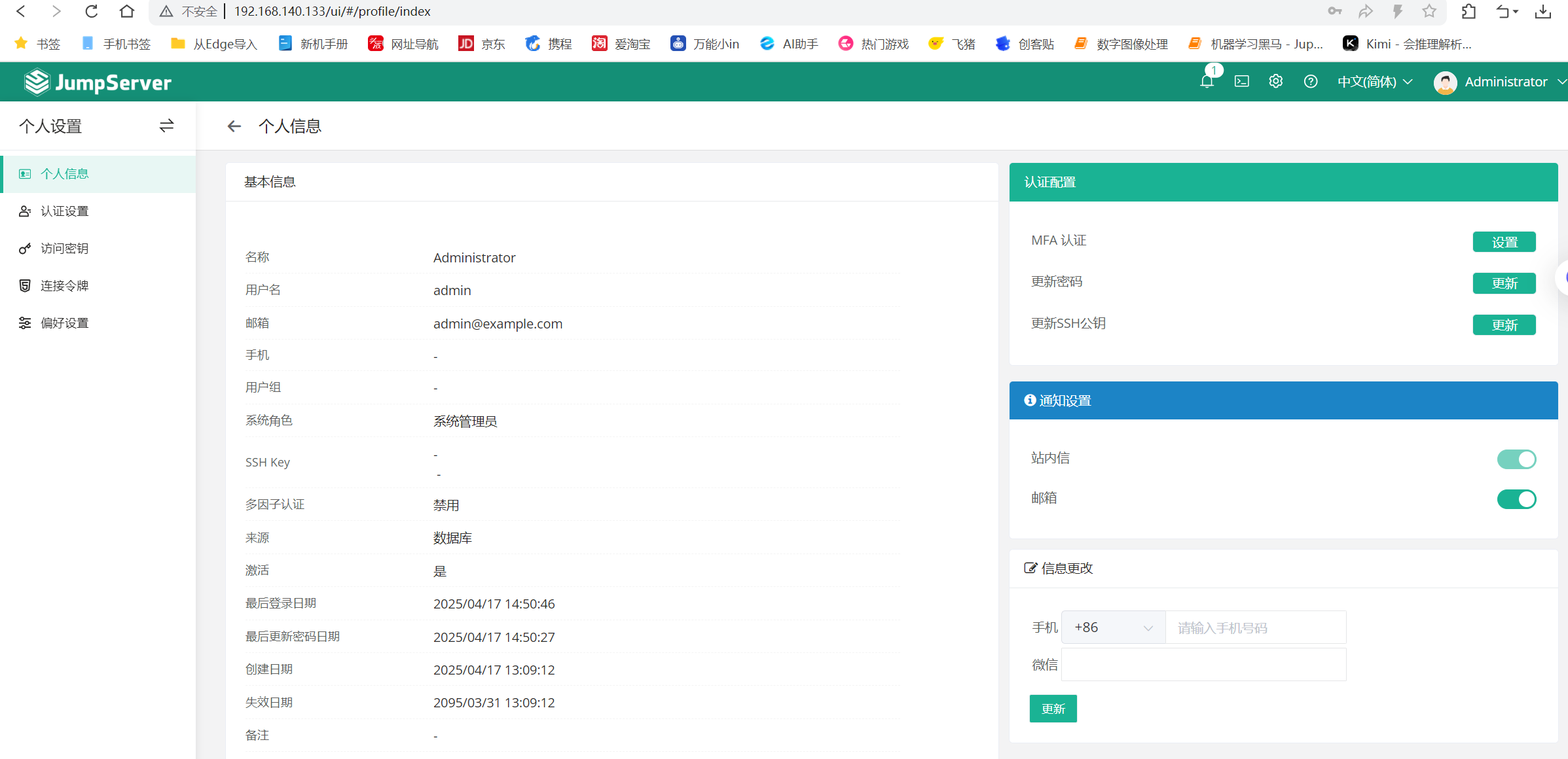
四、部署firewall服務器
# 在firewall服務器上編寫腳本實現SNAT_DNAT功能
[root@firewall ~]# vim snat_dnat.sh#!/bin/bash#清除規則
iptables -F
iptables -t nat -F#開啟路由功能
echo 1 >/proc/sys/net/ipv4/ip_forward#開啟snat功能iptables -t nat -A POSTROUTING -s 192.168.140.0/24 -o ens36 -j SNAT --to-source 192.168.1.86#開啟DNAT功能
iptables -t nat -A PREROUTING -i ens36 -d 192.168.1.86 -p tcp --dport 80 -j DNAT --to-destination 192.168.140.130:80#發布堡壘機
iptables -t nat -A PREROUTING -d 192.168.1.86 -p tcp --dport 2288 -i ens36 -j DNAT --to-destination 192.168.140.133:6677#在k8s集群中的master節點上開啟相應的端口
[root@master ~]# vim open_app.sh
#!/bin/bash# open ssh
iptables -t filter -A INPUT -p tcp --dport 22 -j ACCEPT# open dns
iptables -t filter -A INPUT -p udp --dport 53 -s 192.168.140.0/24 -j ACCEPT# open dhcp
iptables -t filter -A INPUT -p udp --dport 67 -j ACCEPT# open http/https
iptables -t filter -A INPUT -p tcp --dport 80 -j ACCEPT
iptables -t filter -A INPUT -p tcp --dport 443 -j ACCEPT# open mysql
iptables -t filter -A INPUT -p tcp --dport 3306 -j ACCEPT# open Kubernetes API
iptables -A INPUT -p tcp --dport 6443 -j ACCEPT# drop icmp request
iptables -t filter -A INPUT -p icmp --icmp-type 8 -j DROP# default policy DROP
#iptables -t filter -P INPUT DROP五、搭建nfs服務器,保障nginx集群的數據一致性,并且設置提供服務的后端real-server開機自動掛載
1.下載nfs-utils軟件
[root@nfs ~]# yum install nfs-utils -y2.新建共享目錄和index.html
[root@nfs ~]# mkdir /nginx
[root@nfs ~]# cd /nginx
[root@nfs nginx]# echo "hello world" >index.html
[root@nfs nginx]# ls
index.html3.設置共享目錄
[root@nfs ~]# vim /etc/exports
[root@nfs ~]# cat /etc/exports
/nginx 192.168.140.0/24(ro,no_root_squash,sync)4.刷新nfs或者重新輸出共享目錄
[root@nfs ~]# exportfs -r #輸出所有共享目錄
[root@nfs ~]# exportfs -v #顯示輸出的共享目錄
/nginx 192.168.140.0/24(sync,wdelay,hide,no_subtree_check,sec=sys,ro,secure,no_root_squash,no_all_squash)5.重啟nfs服務并且設置nfs開機自啟
[root@nfs web]# systemctl restart nfs && systemctl enable nfs
Created symlink from /etc/systemd/system/multi-user.target.wants/nfs-server.service to /usr/lib/systemd/system/nfs-server.service.創建pv使用nfs服務器上的共享目錄
# 在master上操作
[root@master ~]# mkdir /pv
[root@master ~]# cd /pv
[root@master pv]# vim nfs-pv.yaml
apiVersion: v1
kind: PersistentVolume
metadata:name: pv-weblabels:type: pv-web
spec:capacity:storage: 10Gi accessModes:- ReadWriteManystorageClassName: nfsnfs:path: "/nginx"server: 192.168.140.157readOnly: false[root@master pv]# kubectl apply -f nfs-pv.yaml
persistentvolume/pv-web created[root@master pv]# kubectl get pv
NAME CAPACITY ACCESS MODES RECLAIM POLICY STATUS CLAIM STORAGECLASS REASON AGE
pv-web 10Gi RWX Retain Available nfs 2m22s# 創建pvc
[root@master pv]# vim nfs-pvc.yaml
apiVersion: v1
kind: PersistentVolumeClaim
metadata:name: pvc-web
spec:accessModes:- ReadWriteMany resources:requests:storage: 1GistorageClassName: nfs[root@master pv]# kubectl apply -f nfs-pvc.yaml
persistentvolumeclaim/pvc-web created[root@master pv]# kubectl get pvc
NAME STATUS VOLUME CAPACITY ACCESS MODES STORAGECLASS AGE
pvc-web Bound pv-web 10Gi RWX nfs 11s# 創建pod
[root@master pv]# vim nginx-deployment.yaml
apiVersion: apps/v1
kind: Deployment
metadata:name: nginx-deploymentlabels:app: nginx
spec:replicas: 4selector:matchLabels:app: nginxtemplate:metadata:labels:app: nginxspec:volumes:- name: pv-storage-nfspersistentVolumeClaim:claimName: pvc-webcontainers:- name: pv-container-nfsimage: nginximagePullPolicy: IfNotPresentports:- containerPort: 80name: "http-server"volumeMounts:- mountPath: "/usr/share/nginx/html"name: pv-storage-nfs[root@master pv]# kubectl apply -f nginx-deployment.yaml
deployment.apps/nginx-deployment created[root@master pv]# kubectl get pod -o wide
NAME READY STATUS RESTARTS AGE IP NODE NOMINATED NODE READINESS GATES
nginx-deployment-5ffbcf544-hdn2v 1/1 Running 0 13s 10.224.166.180 node1 <none> <none>
nginx-deployment-5ffbcf544-p6tpx 1/1 Running 0 13s 10.224.166.181 node1 <none> <none>
nginx-deployment-5ffbcf544-wr9m7 1/1 Running 0 13s 10.224.104.53 node2 <none> <none>
nginx-deployment-5ffbcf544-ztkbx 1/1 Running 0 13s 10.224.104.54 node2 <none> <none># 測試
[root@master pv]# curl 10.224.104.53
hello world# 對nfs服務器上index.html的內容進行修改
[root@nfs nginx]# vim index.html
hello world!
welcome to my'web![root@master pv]# curl 10.224.104.53
hello world!
welcome to my'web!六、采用HPA技術來啟動nginx和MySQL的pod,cpu使用率超過80%時進行水平擴縮
部署MySQLpod
# 編寫yaml文件
[root@master ~]# mkdir /mysql
[root@master ~]# cd /mysql/
[root@master mysql]# vim mysql.yaml
apiVersion: apps/v1
kind: Deployment
metadata:labels:app: mysqlname: mysql
spec:replicas: 1selector:matchLabels:app: mysqltemplate:metadata:labels: app: mysqlspec:containers:- image: mysql:latestname: mysqlimagePullPolicy: IfNotPresentenv:- name: MYSQL_ROOT_PASSWORDvalue: "123456"ports:- containerPort: 3306
---
apiVersion: v1
kind: Service
metadata:labels:app: svc-mysqlname: svc-mysql
spec:selector:app: mysqltype: NodePortports:- port: 3306protocol: TCPtargetPort: 3306nodePort: 30007#部署pod
[root@master mysql]# kubectl apply -f mysql.yaml
deployment.apps/mysql created
service/svc-mysql created[root@master mysql]# kubectl get service
NAME TYPE CLUSTER-IP EXTERNAL-IP PORT(S) AGE
kubernetes ClusterIP 10.96.0.1 <none> 443/TCP 14d
svc-mysql NodePort 10.100.245.213 <none> 3306:30006/TCP 20s[root@master mysql]# kubectl get pods
NAME READY STATUS RESTARTS AGE
mysql-597ff9595d-s8kqh 1/1 Running 0 2m11s
nginx-deployment-5ffbcf544-hdn2v 1/1 Running 0 14m
nginx-deployment-5ffbcf544-p6tpx 1/1 Running 0 14m
nginx-deployment-5ffbcf544-wr9m7 1/1 Running 0 14m
nginx-deployment-5ffbcf544-ztkbx 1/1 Running 0 14m# 進入MySQL
[root@master mysql]# kubectl exec -it mysql-597ff9595d-s8kqh -- bash
bash-5.1# mysql -uroot -p123456
mysql: [Warning] Using a password on the command line interface can be insecure.
Welcome to the MySQL monitor. Commands end with ; or \g.
Your MySQL connection id is 9
Server version: 9.3.0 MySQL Community Server - GPLCopyright (c) 2000, 2025, Oracle and/or its affiliates.Oracle is a registered trademark of Oracle Corporation and/or its
affiliates. Other names may be trademarks of their respective
owners.Type 'help;' or '\h' for help. Type '\c' to clear the current input statement.mysql> 部署帶有HPA功能的nginx
# 編寫yaml文件
[root@master ~]# mkdir /hpa
[root@master ~]# cd /hpa
[root@master hpa]# vim nginx-hpa.yaml
apiVersion: apps/v1
kind: Deployment
metadata:name: myweb
spec:selector:matchLabels:run: mywebtemplate:metadata:labels:run: mywebspec:containers:- name: mywebimage: nginximagePullPolicy: IfNotPresentports:- containerPort: 80resources:limits:cpu: 200mrequests:cpu: 50m
---
apiVersion: v1
kind: Service
metadata:name: myweb-svclabels:run: myweb-svc
spec:type: NodePortports:- port: 80targetPort: 80nodePort: 31000selector:run: myweb[root@master hpa]# kubectl apply -f nginx-hpa.yaml
deployment.apps/myweb created
service/myweb-svc created[root@master hpa]# kubectl get pod -o wide
NAME READY STATUS RESTARTS AGE IP NODE NOMINATED NODE READINESS GATES
myweb-55d568cd6c-mc6sp 1/1 Running 0 24s 10.224.104.57 node2 <none> <none># 啟用HPA水平擴縮
[root@master hpa]# kubectl autoscale deployment myweb --cpu-percent=80 --min=1 --max=10
horizontalpodautoscaler.autoscaling/myweb autoscaled安裝metrics-server
# 在master上操作
# 下載components.yaml配置文件
wget https://github.com/kubernetes-sigs/metrics-server/releases/latest/download/components.yaml# 修改components.yaml配置文件
image: registry.aliyuncs.com/google_containers/metrics-server:v0.6.0
imagePullPolicy: IfNotPresent
args:
// 新增下面兩行參數
- --kubelet-insecure-tls
- --kubelet-preferred-address-types=InternalDNS,InternalIP,ExternalDNS,ExternalIP,Hostname[root@master ~]# cat components.yaml
部分代碼如下
spec:containers:- args:- --kubelet-insecure-tls- --cert-dir=/tmp- --secure-port=10250- --kubelet-preferred-address-types=InternalDNS,InternalIP,ExternalDNS,ExternalIP,Hostname- --kubelet-use-node-status-port- --metric-resolution=15simage: registry.aliyuncs.com/google_containers/metrics-server:v0.6.0imagePullPolicy: IfNotPresent# 部署
[root@master ~]# kubectl apply -f components.yaml# 檢查是否安裝成功
[root@master ~]# kubectl get pods -o wide -n kube-system |grep metrics-server
metrics-server-5bd756b4b8-788qj 1/1 Running 0 51s 10.224.104.10 node2 <none> <none>[root@master ~]# kubectl top node
NAME CPU(cores) CPU% MEMORY(bytes) MEMORY%
master 163m 8% 1183Mi 32%
node1 88m 4% 1186Mi 32%
node2 76m 3% 656Mi 17%在nfs服務器上進行ab壓力測試
# 安裝httpd-tools工具
[root@nfs ~]# yum install httpd-tools -y# 模擬用戶訪問業務場景
# ab -n <請求數量> -c <并發數> <URL>
[root@nfs ~]# ab -n 1000 -c 50 http://192.168.121.101:31000/index.html# 在master機器上監控HPA狀態
[root@master ~]# kubectl get hpa --watch# 增加請求數量和并發數量
[root@nfs ~]# ab -n 5000 -c100 http://192.168.121.101:31000/index.html
[root@nfs ~]# ab -n 10000 -c200 http://192.168.121.101:31000/index.html
[root@nfs ~]# ab -n 20000 -c400 http://192.168.121.101:31000/index.html七、構建CI/CD環境,安裝部署Jenkins、harbor實現相關的代碼發布
部署并安裝Jenkins
# 安裝git軟件
[root@master ~]# mkdir /jenkins
[root@master ~]# cd /jenkins
[root@master jenkins]# yum install git -y# 下載yaml文件
[root@master jenkins]# git clone https://github.com/scriptcamp/kubernetes-jenkins# 創建一個命名空間
[root@master jenkins]# cd kubernetes-jenkins/
[root@master kubernetes-jenkins]# cat namespace.yaml
apiVersion: v1
kind: Namespace
metadata:name: devops-tools[root@master kubernetes-jenkins]# kubectl apply -f namespace.yaml
namespace/devops-tools created# 查看命名空間
[root@master kubernetes-jenkins]# kubectl get ns
NAME STATUS AGE
default Active 39h
devops-tools Active 89s
kube-node-lease Active 39h
kube-public Active 39h
kube-system Active 39h# 創建服務賬號,集群角色綁定
[root@master kubernetes-jenkins]# vim serviceAccount.yaml
---
apiVersion: rbac.authorization.k8s.io/v1
kind: ClusterRole
metadata:name: jenkins-admin
rules:- apiGroups: [""]resources: ["*"]verbs: ["*"]---
apiVersion: v1
kind: ServiceAccount
metadata:name: jenkins-adminnamespace: devops-tools---
apiVersion: rbac.authorization.k8s.io/v1
kind: ClusterRoleBinding
metadata:name: jenkins-admin
roleRef:apiGroup: rbac.authorization.k8s.iokind: ClusterRolename: jenkins-admin
subjects:
- kind: ServiceAccountname: jenkins-adminnamespace: devops-tools[root@master kubernetes-jenkins]# kubectl apply -f serviceAccount.yaml
clusterrole.rbac.authorization.k8s.io/jenkins-admin unchanged
serviceaccount/jenkins-admin unchanged
clusterrolebinding.rbac.authorization.k8s.io/jenkins-admin created# 創建卷
[root@master kubernetes-jenkins]# vim volume.yamlkind: StorageClass
apiVersion: storage.k8s.io/v1
metadata:name: local-storage
provisioner: kubernetes.io/no-provisioner
volumeBindingMode: WaitForFirstConsumer---
apiVersion: v1
kind: PersistentVolume
metadata:name: jenkins-pv-volumelabels:type: local
spec:storageClassName: local-storageclaimRef:name: jenkins-pv-claimnamespace: devops-toolscapacity:storage: 10GiaccessModes:- ReadWriteOncelocal:path: /mntnodeAffinity:required:nodeSelectorTerms:- matchExpressions:- key: kubernetes.io/hostnameoperator: Invalues:- node1 # 改為自己k8s集群里的node節點名字---
apiVersion: v1
kind: PersistentVolumeClaim
metadata:name: jenkins-pv-claimnamespace: devops-tools
spec:storageClassName: local-storageaccessModes:- ReadWriteOnceresources:requests:storage: 3Gi[root@master kubernetes-jenkins]# kubectl apply -f volume.yaml
storageclass.storage.k8s.io/local-storage created
persistentvolume/jenkins-pv-volume created
persistentvolumeclaim/jenkins-pv-claim created[root@master kubernetes-jenkins]# kubectl get pv
NAME CAPACITY ACCESS MODES RECLAIM POLICY STATUS CLAIM STORAGECLASS REASON AGE
jenkins-pv-volume 10Gi RWO Retain Bound devops-tools/jenkins-pv-claim local-storage 22s
pv-web 10Gi RWX Retain Bound default/pvc-web nfs 17h[root@master kubernetes-jenkins]# kubectl describe pv jenkins-pv-volume
Name: jenkins-pv-volume
Labels: type=local
Annotations: <none>
Finalizers: [kubernetes.io/pv-protection]
StorageClass: local-storage
Status: Bound
Claim: devops-tools/jenkins-pv-claim
Reclaim Policy: Retain
Access Modes: RWO
VolumeMode: Filesystem
Capacity: 10Gi
Node Affinity: Required Terms: Term 0: kubernetes.io/hostname in [node1]
Message:
Source:Type: LocalVolume (a persistent volume backed by local storage on a node)Path: /mnt
Events: <none># 部署Jenkins
[root@master kubernetes-jenkins]# cat deployment.yaml
apiVersion: apps/v1
kind: Deployment
metadata:name: jenkinsnamespace: devops-tools
spec:replicas: 1selector:matchLabels:app: jenkins-servertemplate:metadata:labels:app: jenkins-serverspec:securityContext:fsGroup: 1000 runAsUser: 1000serviceAccountName: jenkins-admincontainers:- name: jenkinsimage: jenkins/jenkins:ltsimagePullPolicy: IfNotPresentresources:limits:memory: "2Gi"cpu: "1000m"requests:memory: "500Mi"cpu: "500m"ports:- name: httpportcontainerPort: 8080- name: jnlpportcontainerPort: 50000livenessProbe:httpGet:path: "/login"port: 8080initialDelaySeconds: 90periodSeconds: 10timeoutSeconds: 5failureThreshold: 5readinessProbe:httpGet:path: "/login"port: 8080initialDelaySeconds: 60periodSeconds: 10timeoutSeconds: 5failureThreshold: 3volumeMounts:- name: jenkins-datamountPath: /var/jenkins_home volumes:- name: jenkins-datapersistentVolumeClaim:claimName: jenkins-pv-claim[root@master kubernetes-jenkins]# kubectl apply -f deployment.yaml
deployment.apps/jenkins created[root@master kubernetes-jenkins]# kubectl get deploy -n devops-tools
NAME READY UP-TO-DATE AVAILABLE AGE
jenkins 1/1 1 1 7m[root@master kubernetes-jenkins]# kubectl get pod -n devops-tools
NAME READY STATUS RESTARTS AGE
jenkins-b96f7764f-hf24r 1/1 Running 0 6m7s# 發布Jenkins pod
[root@master kubernetes-jenkins]# cat service.yaml
apiVersion: v1
kind: Service
metadata:name: jenkins-servicenamespace: devops-toolsannotations:prometheus.io/scrape: 'true'prometheus.io/path: /prometheus.io/port: '8080'
spec:selector: app: jenkins-servertype: NodePort ports:- port: 8080targetPort: 8080nodePort: 32000[root@master kubernetes-jenkins]# kubectl apply -f service.yaml
service/jenkins-service created[root@master kubernetes-jenkins]# kubectl get svc -n devops-tools
NAME TYPE CLUSTER-IP EXTERNAL-IP PORT(S) AGE
jenkins-service NodePort 10.98.133.177 <none> 8080:32000/TCP 8s# 使用瀏覽器訪問宿主機的IP+端口號
http://192.168.140.130:32000# 進入pod里獲取密碼
[root@master kubernetes-jenkins]# kubectl exec -it jenkins-b96f7764f-hf24r -n devops-tools -- bash
jenkins@jenkins-b96f7764f-hf24r:/$ cat /var/jenkins_home/secrets/initialAdminPassword
ad4fbdcf630a4f43ab955d6c91a58890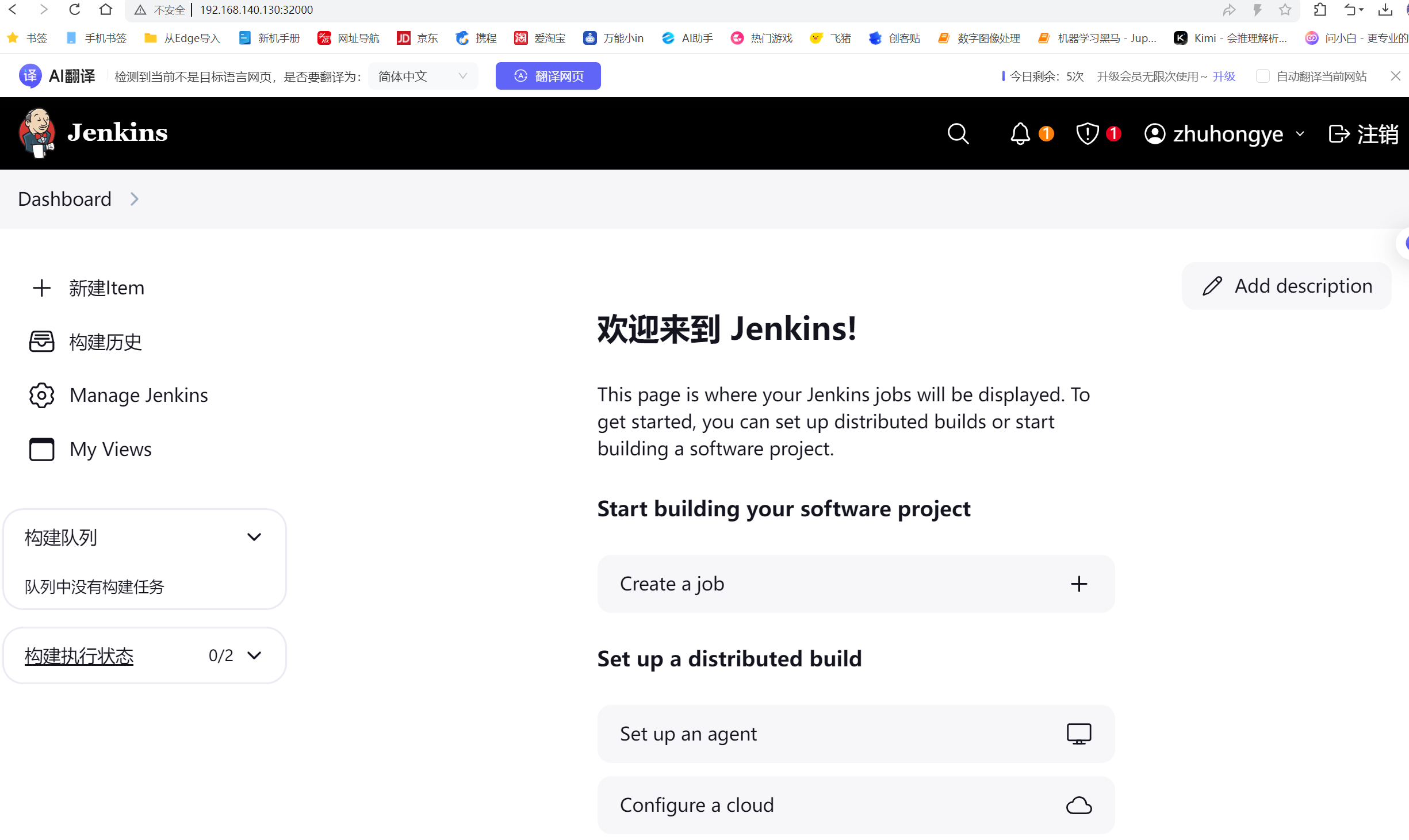
部署安裝Gitlab
# 部署gitlab
https://gitlab.cn/install/[root@localhost ~]# hostnamectl set-hostname gitlab
[root@localhost ~]# su - root
su - root
上一次登錄:日 6月 18 18:28:08 CST 2023從 192.168.2.240pts/0 上
[root@gitlab ~]# cd /etc/sysconfig/network-scripts/
[root@gitlab network-scripts]# vim ifcfg-ens33
[root@gitlab network-scripts]# service network restart
Restarting network (via systemctl): [ 確定 ]
[root@gitlab network-scripts]# sed -i 's/SELINUX=enforcing/SELINUX=disabled/g' /etc/selinux/config
[root@gitlab network-scripts]# service firewalld stop && systemctl disable firewalld
Redirecting to /bin/systemctl stop firewalld.service
Removed symlink /etc/systemd/system/multi-user.target.wants/firewalld.service.
Removed symlink /etc/systemd/system/dbus-org.fedoraproject.FirewallD1.service.
[root@gitlab network-scripts]# reboot
[root@gitlab ~]# getenforce
Disabled# 1.安裝和配置必須的依賴項
yum install -y curl policycoreutils-python openssh-server perl# 2.配置極狐GitLab 軟件源鏡像
[root@gitlab ~]# curl -fsSL https://packages.gitlab.cn/repository/raw/scripts/setup.sh | /bin/bash
==> Detected OS centos==> Add yum repo file to /etc/yum.repos.d/gitlab-jh.repo[gitlab-jh]
name=JiHu GitLab
baseurl=https://packages.gitlab.cn/repository/el/$releasever/
gpgcheck=0
gpgkey=https://packages.gitlab.cn/repository/raw/gpg/public.gpg.key
priority=1
enabled=1==> Generate yum cache for gitlab-jh==> Successfully added gitlab-jh repo. To install JiHu GitLab, run "sudo yum/dnf install gitlab-jh".[root@gitlab ~]# yum install gitlab-jh -y
Thank you for installing JiHu GitLab!
GitLab was unable to detect a valid hostname for your instance.
Please configure a URL for your JiHu GitLab instance by setting `external_url`
configuration in /etc/gitlab/gitlab.rb file.
Then, you can start your JiHu GitLab instance by running the following command:sudo gitlab-ctl reconfigureFor a comprehensive list of configuration options please see the Omnibus GitLab readme
https://jihulab.com/gitlab-cn/omnibus-gitlab/-/blob/main-jh/README.mdHelp us improve the installation experience, let us know how we did with a 1 minute survey:
https://wj.qq.com/s2/10068464/dc66[root@gitlab ~]# vim /etc/gitlab/gitlab.rb
external_url 'http://gitlab.example.com'[root@gitlab ~]# gitlab-ctl reconfigure
Notes:
Default admin account has been configured with following details:
Username: root
Password: You didn't opt-in to print initial root password to STDOUT.
Password stored to /etc/gitlab/initial_root_password. This file will be cleaned up in first reconfigure run after 24 hours.
NOTE: Because these credentials might be present in your log files in plain text, it is highly recommended to reset the password following https://docs.gitlab.com/ee/security/reset_user_password.html#reset-your-root-password.
gitlab Reconfigured!
# 查看密碼
[root@gitlab ~]# cat /etc/gitlab/initial_root_password
# WARNING: This value is valid only in the following conditions
# 1. If provided manually (either via `GITLAB_ROOT_PASSWORD` environment variable or via `gitlab_rails['initial_root_password']` setting in `gitlab.rb`, it was provided before database was seeded for the first time (usually, the first reconfigure run).
# 2. Password hasn't been changed manually, either via UI or via command line.
#
# If the password shown here doesn't work, you must reset the admin password following https://docs.gitlab.com/ee/security/reset_user_password.html#reset-your-root-password.Password: LfkwPEmMt6KTa94Q2S4LvArCEGoQcPYmSFzYSKOiHdg=# NOTE: This file will be automatically deleted in the first reconfigure run after 24 hours.# 可以登錄后修改語言為中文
# 用戶的profile/preferences# 修改密碼[root@gitlab ~]# gitlab-rake gitlab:env:infoSystem information
System:
Proxy: no
Current User: git
Using RVM: no
Ruby Version: 3.0.6p216
Gem Version: 3.4.13
Bundler Version:2.4.13
Rake Version: 13.0.6
Redis Version: 6.2.11
Sidekiq Version:6.5.7
Go Version: unknownGitLab information
Version: 16.0.4-jh
Revision: c2ed99db36f
Directory: /opt/gitlab/embedded/service/gitlab-rails
DB Adapter: PostgreSQL
DB Version: 13.11
URL: http://myweb.first.com
HTTP Clone URL: http://myweb.first.com/some-group/some-project.git
SSH Clone URL: git@myweb.first.com:some-group/some-project.git
Elasticsearch: no
Geo: no
Using LDAP: no
Using Omniauth: yes
Omniauth Providers: GitLab Shell
Version: 14.20.0
Repository storages:
- default: unix:/var/opt/gitlab/gitaly/gitaly.socket
GitLab Shell path: /opt/gitlab/embedded/service/gitlab-shell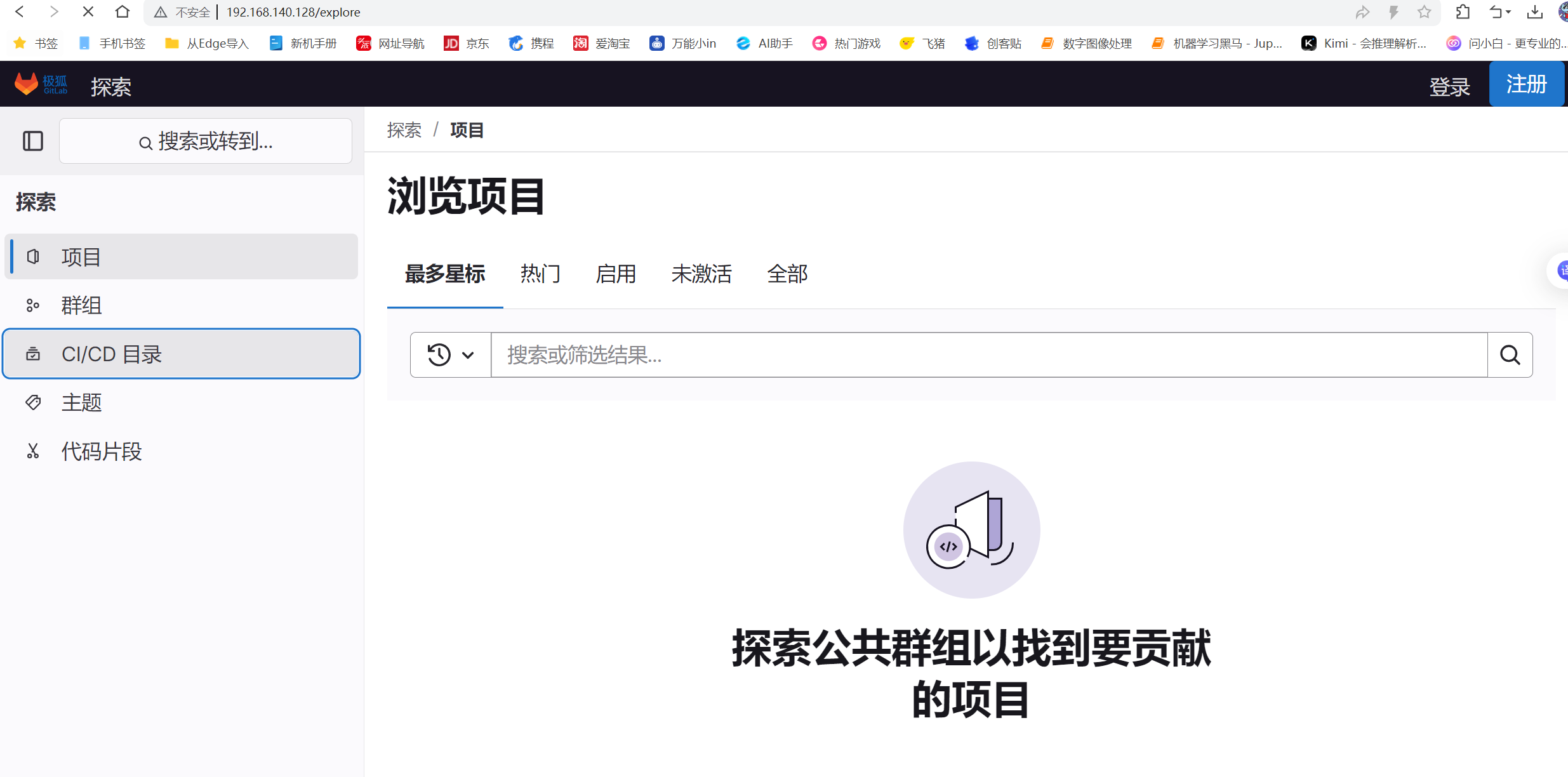
部署安裝harbor
# 準備一臺2核4G內存的虛擬機
# 配置好阿里云的repo源
[root@harbor ~]# yum install yum-utils -y
[root@harbor ~]# yum-config-manager --add-repo http://mirrors.aliyun.com/docker-ce/linux/centos/docker-ce.repo# 安裝docker
[root@harbor ~]# yum install docker-ce -y# 啟動docker,設置開機啟動
[root@harbor ~]# systemctl start docker
[root@harbor ~]# systemctl enable docker.service# 查看docker和docker compose的版本
[root@harbor ~]# docker version
[root@harbor ~]# docker compose version# 安裝harbor
[root@harbor ~]# wget https://github.com/goharbor/harbor/releases/download/v2.8.3/harbor-offline-installer-v2.8.3.tgz# 解壓
[root@harbor ~]# ls
anaconda-ks.cfg harbor-offline-installer-v2.8.3.tgz
[root@harbor ~]# tar xf harbor-offline-installer-v2.8.3.tgz# 修改配置文件
[root@harbor ~]# ls
anaconda-ks.cfg harbor harbor-offline-installer-v2.8.3.tgz[root@harbor ~]# cd harbor
[root@harbor harbor]# ls
common.sh harbor.yml.tmpl LICENSE
harbor.v2.8.3.tar.gz install.sh prepare[root@harbor harbor]# vim harbor.yml.tmpl
# The IP address or hostname to access admin UI and registry service.
# DO NOT use localhost or 127.0.0.1, because Harbor needs to be accessed by external clients.
hostname: 192.168.140.159 #修改為主機ip地址# http related config
http:# port for http, default is 80. If https enabled, this port will redirect to https portport: 5001 #端口可以修改#如果開啟https功能的話,需要在對應位置添加證書路徑(要有證書)
https:# https port for harbor, default is 443port: 443# The path of cert and key files for nginxcertificate: /root/harbor/nginx.crtprivate_key: /root/harbor/ca.key
# 其余地方不做修改 # 安裝harbor
[root@harbor harbor]# mv harbor.yml.tmpl harbor.yml
[root@harbor harbor]# ./install.sh
[+] Running 9/10? Network harbor_harbor Created 2.8s ? Container harbor-log Started 0.5s ? Container registry Started 1.5s ? Container harbor-db Started 1.2s ? Container harbor-portal Started 1.6s ? Container redis Started 1.5s ? Container registryctl Started 1.2s ? Container harbor-core Started 1.9s ? Container harbor-jobservice Started 2.4s ? Container nginx Started 2.5s
? ----Harbor has been installed and started successfully.----[root@harbor harbor]# docker compose ps|grep harbor
WARN[0000] /root/harbor/docker-compose.yml: `version` is obsolete
harbor-core goharbor/harbor-core:v2.8.3 "/harbor/entrypoint.…" core 2 minutes ago Up 2 minutes (healthy)
harbor-db goharbor/harbor-db:v2.8.3 "/docker-entrypoint.…" postgresql 2 minutes ago Up 2 minutes (healthy)
harbor-jobservice goharbor/harbor-jobservice:v2.8.3 "/harbor/entrypoint.…" jobservice 2 minutes ago Up 2 minutes (healthy)
harbor-log goharbor/harbor-log:v2.8.3 "/bin/sh -c /usr/loc…" log 2 minutes ago Up 2 minutes (healthy) 127.0.0.1:1514->10514/tcp
harbor-portal goharbor/harbor-portal:v2.8.3 "nginx -g 'daemon of…" portal 2 minutes ago Up 2 minutes (healthy)
nginx goharbor/nginx-photon:v2.8.3 "nginx -g 'daemon of…" proxy 2 minutes ago Up 2 minutes (healthy) 0.0.0.0:5001->8080/tcp, :::5001->8080/tcp
redis goharbor/redis-photon:v2.8.3 "redis-server /etc/r…" redis 2 minutes ago Up 2 minutes (healthy)
registry goharbor/registry-photon:v2.8.3 "/home/harbor/entryp…" registry 2 minutes ago Up 2 minutes (healthy)
registryctl goharbor/harbor-registryctl:v2.8.3 "/home/harbor/start.…" registryctl 2 minutes ago Up 2 minutes (healthy) # 用瀏覽器訪問,測試效果
http://192.168.140.159:5001/
賬號:admin
密碼:Harbor12345
新建一個項目:k8s-harbor
新建一個用戶:user
密碼:Aa12345678
授權k8s-harbor項目允許用戶user去訪問,授予項目管理員權限# 實現k8s集群使用harbor倉庫
[root@master ~]# vim /etc/docker/daemon.json
{"exec-opts": ["native.cgroupdriver=systemd"],"registry-mirrors": ["https://docker.xuanyuan.me","https://registry.docker-cn.com","http://hub-mirror.c.163.com","https://reg-mirror.qiniu.com","https://docker.mirrors.ustc.edu.cn"],"insecure-registries": ["192.168.140.159:5001"],"data-root": "/opt/lib/docker"
}
#保存文件后,重啟Docker服務
systemctl daemon-reload
systemctl restart docker測試harbor的鏡像上傳和拉取
# 在原來安裝harbor的宿主機上,重新啟動harbor相關的容器
[root@docker harbor]# cd /harbor
[root@docker harbor]# docker compose up -d# master上登陸harbor倉庫
[root@master ~]# docker login 192.168.140.159:5001
Username: user
Password:
WARNING! Your password will be stored unencrypted in /root/.docker/config.json.
Configure a credential helper to remove this warning. See
https://docs.docker.com/engine/reference/commandline/login/#credentials-storeLogin Succeeded# 將master上的nginx鏡像上傳到倉庫里
[root@master ~]# docker tag nginx:latest 192.168.140.159:5001/k8s-harbor/nginx:latest
[root@master ~]# docker images
REPOSITORY TAG IMAGE ID CREATED SIZE
192.168.121.105:5001/k8s-harbor/nginx latest 92b11f67642b 7 weeks ago 187MB[root@master ~]# docker push 192.168.140.159:5001/k8s-harbor/nginx:latest# 在nfs服務器上拉取harbor倉庫里的nginx鏡像
[root@nfs ~]# vim /etc/docker/daemon.json
{"exec-opts": ["native.cgroupdriver=systemd"],"registry-mirrors": ["https://docker.xuanyuan.me","https://registry.docker-cn.com","http://hub-mirror.c.163.com","https://reg-mirror.qiniu.com","https://docker.mirrors.ustc.edu.cn"],"insecure-registries": ["192.168.140.159:5001"],"data-root": "/opt/lib/docker"
}# 重啟docker
[root@nfs ~]# systemctl daemon-reload
[root@nfs ~]# systemctl restart docker# 登陸harbor倉庫
[root@nfs ~]# docker login 192.168.140.159:5001#在nfs服務器上從harbor拉取鏡像
[root@nfs ~]# docker pull 192.168.140.159:5001/k8s-harbor/nginx:latest#查看是否拉取成功
[root@nfs ~]# docker images|grep nginx
192.168.140.159:5001/k8s-harbor/nginx latest 4e1b6bae1e48 2 days ago 192MB八、使用ingress,給web業務做基于域名的負載均衡
安裝ingress controller
[root@master ~]# mkdir /ingress
[root@master ~]# cd /ingress/
[root@master ingress]# ls
ingress-controller-deploy.yaml kube-webhook-certgen-v1.1.0.tar.gz
ingress-nginx-controllerv1.1.0.tar.gz nginx-svc-1.yaml
ingress.yaml nginx-svc-2.yaml# 將鏡像傳到所有的node節點服務器上
[root@master ingress]# scp kube-webhook-certgen-v1.1.0.tar.gz node2:/root
[root@master ingress]# scp kube-webhook-certgen-v1.1.0.tar.gz node1:/root
[root@master ingress]# scp ingress-nginx-controllerv1.1.0.tar.gz node1:/root
[root@master ingress]# scp ingress-nginx-controllerv1.1.0.tar.gz node2:/root# 在node1和node2上導入鏡像
[root@node1 ~]# docker load -i ingress-nginx-controllerv1.1.0.tar.gz
[root@node1 ~]# docker load -i kube-webhook-certgen-v1.1.0.tar.gz
[root@node1 ~]# docker images
REPOSITORY TAG IMAGE ID CREATED SIZE
registry.cn-hangzhou.aliyuncs.com/google_containers/nginx-ingress-controller v1.1.0 ae1a7201ec95 2 years ago 285MB
registry.cn-hangzhou.aliyuncs.com/google_containers/kube-webhook-certgen v1.1.1 c41e9fcadf5a 2 years ago 47.7MB# 使用ingress-controller-deploy.yaml文件啟動ingress controller
[root@master ingress]# kubectl apply -f ingress-controller-deploy.yaml
namespace/ingress-nginx created
serviceaccount/ingress-nginx created
configmap/ingress-nginx-controller created
clusterrole.rbac.authorization.k8s.io/ingress-nginx created
clusterrolebinding.rbac.authorization.k8s.io/ingress-nginx created
role.rbac.authorization.k8s.io/ingress-nginx created
rolebinding.rbac.authorization.k8s.io/ingress-nginx created
service/ingress-nginx-controller-admission created
service/ingress-nginx-controller created
deployment.apps/ingress-nginx-controller created
ingressclass.networking.k8s.io/nginx created
validatingwebhookconfiguration.admissionregistration.k8s.io/ingress-nginx-admission created
serviceaccount/ingress-nginx-admission created
clusterrole.rbac.authorization.k8s.io/ingress-nginx-admission created
clusterrolebinding.rbac.authorization.k8s.io/ingress-nginx-admission created
role.rbac.authorization.k8s.io/ingress-nginx-admission created
rolebinding.rbac.authorization.k8s.io/ingress-nginx-admission created
job.batch/ingress-nginx-admission-create created
job.batch/ingress-nginx-admission-patch created# 查看命名空間
[root@master ingress]# kubectl get namespace
NAME STATUS AGE
default Active 44h
devops-tools Active 5h30m
ingress-nginx Active 14s
kube-node-lease Active 44h
kube-public Active 44h
kube-system Active 44h# 查看相關service
[root@master ingress]# kubectl get svc -n ingress-nginx
NAME TYPE CLUSTER-IP EXTERNAL-IP PORT(S) AGE
ingress-nginx-controller NodePort 10.101.156.215 <none> 80:32023/TCP,443:30325/TCP 2m47s
ingress-nginx-controller-admission ClusterIP 10.105.220.120 <none> 443/TCP 2m47s# 查看相關pod
[root@master ingress]# kubectl get pod -n ingress-nginx
NAME READY STATUS RESTARTS AGE
ingress-nginx-admission-create-cpd95 0/1 Completed 0 3m28s
ingress-nginx-admission-patch-jdk4w 0/1 Completed 1 3m28s
ingress-nginx-controller-7cd558c647-2d878 1/1 Running 0 3m28s
ingress-nginx-controller-7cd558c647-ct69k 1/1 Running 0 3m28s創建pod和暴露pod服務
[root@master ingress]# vim nginx-svc-1.yaml
apiVersion: apps/v1
kind: Deployment
metadata:name: nginx-deploy-1labels:app: nginx-1
spec:replicas: 3selector:matchLabels:app: nginx-1template:metadata:labels:app: nginx-1spec:containers:- name: nginx-1image: nginximagePullPolicy: IfNotPresentports:- containerPort: 80
---
apiVersion: v1
kind: Service
metadata:name: nginx-svc-1labels:app: nginx-svc-1
spec:selector:app: nginx-1ports:- name: name-of-service-portprotocol: TCPport: 80targetPort: 80[root@master ingress]# vim nginx-svc-2.yaml
apiVersion: apps/v1
kind: Deployment
metadata:name: nginx-deploy-2labels:app: nginx-2
spec:replicas: 3selector:matchLabels:app: nginx-2template:metadata:labels:app: nginx-2spec:containers:- name: nginx-2image: nginximagePullPolicy: IfNotPresentports:- containerPort: 80
---
apiVersion: v1
kind: Service
metadata:name: nginx-svc-2labels:app: nginx-svc-2
spec:selector:app: nginx-2ports:- name: name-of-service-portprotocol: TCPport: 80targetPort: 80[root@master ingress]# kubectl apply -f nginx-svc-1.yaml
deployment.apps/nginx-deploy-1 created
service/nginx-svc-1 created
[root@master ingress]# kubectl apply -f nginx-svc-2.yaml
deployment.apps/nginx-deploy-2 created
service/nginx-svc-2 created
啟用ingress關聯ingress controller和service
[root@master ingress]# vim ingress-url.yaml
apiVersion: networking.k8s.io/v1
kind: Ingress
metadata:name: simple-fanout-exampleannotations:kubernets.io/ingress.class: nginx
spec:ingressClassName: nginxrules:- host: www.qqx.comhttp:paths:- path: /foopathType: Prefixbackend:service:name: nginx-svc-1port:number: 80- path: /barpathType: Prefixbackend:service:name: nginx-svc-2port:number: 80[root@master ingress]# kubectl apply -f ingress-url.yaml
ingress.networking.k8s.io/simple-fanout-example created[root@master ingress]# kubectl get ingress
NAME CLASS HOSTS ADDRESS PORTS AGE
simple-fanout-example nginx www.qqx.com 192.168.140.131,192.168.140.132 80 44m
在nfs服務器上進行測試,需要在/etc/hosts文件里添加域名解析記錄
[root@nfs ~]# vim /etc/hosts
127.0.0.1 localhost localhost.localdomain localhost4 localhost4.localdomain4
::1 localhost localhost.localdomain localhost6 localhost6.localdomain6
192.168.140.131 www.qqx.com
192.168.140.132 www.qqx.com [root@master ingress]# kubectl get pod
NAME READY STATUS RESTARTS AGE
nginx-deploy-1-75d4755db9-chbvh 1/1 Running 0 29m
nginx-deploy-1-75d4755db9-dd5z8 1/1 Running 0 29m
nginx-deploy-1-75d4755db9-k59dg 1/1 Running 0 29m
nginx-deploy-2-5c47798b5f-4n5ct 1/1 Running 0 29m
nginx-deploy-2-5c47798b5f-4pnh6 1/1 Running 0 29m
nginx-deploy-2-5c47798b5f-wzrf6 1/1 Running 0 29m# 進入service1對應的一個pod里
[root@master ingress]# kubectl exec -it nginx-deploy-1-75d4755db9-dd5z8 -- bash# 新建/for文件夾以及index.html網頁文件
root@nginx-deploy-1-75d4755db9-dd5z8:/# cd /usr/share/nginx/html/
root@nginx-deploy-1-75d4755db9-dd5z8:/usr/share/nginx/html# mkdir /foo
root@nginx-deploy-1-75d4755db9-dd5z8:/usr/share/nginx/html# cd /foo/
root@nginx-deploy-1-75d4755db9-dd5z8:/foo# echo "this is www.qqx.com/foo/" >index.html
root@nginx-deploy-1-75d4755db9-dd5z8:/foo# exit# 同理,進入service2上的pod并新建/bar文件夾以及index.html網頁文件
[root@master ingress]# kubectl exec -it nginx-deploy-2-5c47798b5f-4pnh6 -- bash
root@nginx-deploy-2-5c47798b5f-4pnh6:/# cd /usr/share/nginx/html/
root@nginx-deploy-2-5c47798b5f-4pnh6:/usr/share/nginx/html# mkdir bar
root@nginx-deploy-2-5c47798b5f-4pnh6:/usr/share/nginx/html# cd bar/
root@nginx-deploy-2-5c47798b5f-4pnh6:/usr/share/nginx/html/bar# echo "this is www.qqx.com/bar/" >index.html
root@nginx-deploy-2-5c47798b5f-4pnh6:/usr/share/nginx/html/bar# exit# 在nfs服務器上
[root@nfs ~]# curl www.qqx.com/foo/index.html
this is www.qqx.com/foo/
[root@nfs ~]# curl www.qqx.com/bar/index.html
this is www.qqx.com/bar/
九、使用探針監控web業務的pod,出現問題馬上重啟,增強業務可靠性
[root@master /]# mkdir /probe
[root@master /]# cd /probe/# 為了和第五步的myweb.yaml區分,下面的myweb都加上后綴
[root@master probe]# vim myweb2.yaml
apiVersion: apps/v1
kind: Deployment
metadata:labels:app: myweb2name: myweb2
spec:replicas: 3selector:matchLabels:app: myweb2template:metadata:labels:app: myweb2spec:containers:- name: myweb2image: nginximagePullPolicy: IfNotPresentports:- containerPort: 8000resources:limits:cpu: 300mrequests:cpu: 100mlivenessProbe:exec:command:- ls- /tmpinitialDelaySeconds: 5periodSeconds: 5readinessProbe:exec:command:- ls- /tmpinitialDelaySeconds: 5periodSeconds: 5 startupProbe:httpGet:path: /port: 8000failureThreshold: 30periodSeconds: 10
---
apiVersion: v1
kind: Service
metadata:labels:app: myweb2-svcname: myweb2-svc
spec:selector:app: myweb2type: NodePortports:- port: 8000protocol: TCPtargetPort: 8000nodePort: 30001[root@master probe]# kubectl apply -f myweb2.yaml
deployment.apps/myweb2 unchanged
service/myweb2-svc created[root@master probe]# kubectl get pod |grep -i myweb2
myweb2-7c4dcb8459-7vn8d 1/1 Running 2 (84s ago) 11m
myweb2-7c4dcb8459-jxdpf 1/1 Running 2 (84s ago) 11m
myweb2-7c4dcb8459-zc9n7 1/1 Running 2 (84s ago) 11m[root@master probe]# kubectl describe pod myweb2-7c4dcb8459-zc9n7
Liveness: exec [ls /tmp] delay=5s timeout=1s period=5s #success=1 #failure=3
Readiness: exec [ls /tmp] delay=5s timeout=1s period=5s #success=1 #failure=3
Startup: http-get http://:8000/ delay=0s timeout=1s period=10s #success=1 #failure=30
十、使用dashboard掌控整個web集群的資源
[root@master ~]# mkdir /dashboard
[root@master ~]# cd /dashboard
[root@master dashboard]# vim recommended.yaml
[root@master dashboard]# cat recommended.yaml
# Copyright 2017 The Kubernetes Authors.
#
# Licensed under the Apache License, Version 2.0 (the "License");
# you may not use this file except in compliance with the License.
# You may obtain a copy of the License at
#
# http://www.apache.org/licenses/LICENSE-2.0
#
# Unless required by applicable law or agreed to in writing, software
# distributed under the License is distributed on an "AS IS" BASIS,
# WITHOUT WARRANTIES OR CONDITIONS OF ANY KIND, either express or implied.
# See the License for the specific language governing permissions and
# limitations under the License.apiVersion: v1
kind: Namespace
metadata:name: kubernetes-dashboard---apiVersion: v1
kind: ServiceAccount
metadata:labels:k8s-app: kubernetes-dashboardname: kubernetes-dashboardnamespace: kubernetes-dashboard---kind: Service
apiVersion: v1
metadata:labels:k8s-app: kubernetes-dashboardname: kubernetes-dashboardnamespace: kubernetes-dashboard
spec:type: NodePort # 關鍵修改:將 ClusterIP 改為 NodePortports:- port: 443targetPort: 8443nodePort: 30088 # 手動指定 NodePort 端口(范圍 30000-32767)selector:k8s-app: kubernetes-dashboard---apiVersion: v1
kind: Secret
metadata:labels:k8s-app: kubernetes-dashboardname: kubernetes-dashboard-certsnamespace: kubernetes-dashboard
type: Opaque---apiVersion: v1
kind: Secret
metadata:labels:k8s-app: kubernetes-dashboardname: kubernetes-dashboard-csrfnamespace: kubernetes-dashboard
type: Opaque
data:csrf: ""---apiVersion: v1
kind: Secret
metadata:labels:k8s-app: kubernetes-dashboardname: kubernetes-dashboard-key-holdernamespace: kubernetes-dashboard
type: Opaque---kind: ConfigMap
apiVersion: v1
metadata:labels:k8s-app: kubernetes-dashboardname: kubernetes-dashboard-settingsnamespace: kubernetes-dashboard---kind: Role
apiVersion: rbac.authorization.k8s.io/v1
metadata:labels:k8s-app: kubernetes-dashboardname: kubernetes-dashboardnamespace: kubernetes-dashboard
rules:# Allow Dashboard to get, update and delete Dashboard exclusive secrets.- apiGroups: [""]resources: ["secrets"]resourceNames: ["kubernetes-dashboard-key-holder", "kubernetes-dashboard-certs", "kubernetes-dashboard-csrf"]verbs: ["get", "update", "delete"]# Allow Dashboard to get and update 'kubernetes-dashboard-settings' config map.- apiGroups: [""]resources: ["configmaps"]resourceNames: ["kubernetes-dashboard-settings"]verbs: ["get", "update"]# Allow Dashboard to get metrics.- apiGroups: [""]resources: ["services"]resourceNames: ["heapster", "dashboard-metrics-scraper"]verbs: ["proxy"]- apiGroups: [""]resources: ["services/proxy"]resourceNames: ["heapster", "http:heapster:", "https:heapster:", "dashboard-metrics-scraper", "http:dashboard-metrics-scraper"]verbs: ["get"]---kind: ClusterRole
apiVersion: rbac.authorization.k8s.io/v1
metadata:labels:k8s-app: kubernetes-dashboardname: kubernetes-dashboard
rules:# Allow Metrics Scraper to get metrics from the Metrics server- apiGroups: ["metrics.k8s.io"]resources: ["pods", "nodes"]verbs: ["get", "list", "watch"]---apiVersion: rbac.authorization.k8s.io/v1
kind: RoleBinding
metadata:labels:k8s-app: kubernetes-dashboardname: kubernetes-dashboardnamespace: kubernetes-dashboard
roleRef:apiGroup: rbac.authorization.k8s.iokind: Rolename: kubernetes-dashboard
subjects:- kind: ServiceAccountname: kubernetes-dashboardnamespace: kubernetes-dashboard---apiVersion: rbac.authorization.k8s.io/v1
kind: ClusterRoleBinding
metadata:name: kubernetes-dashboard
roleRef:apiGroup: rbac.authorization.k8s.iokind: ClusterRolename: kubernetes-dashboard
subjects:- kind: ServiceAccountname: kubernetes-dashboardnamespace: kubernetes-dashboard---kind: Deployment
apiVersion: apps/v1
metadata:labels:k8s-app: kubernetes-dashboardname: kubernetes-dashboardnamespace: kubernetes-dashboard
spec:replicas: 1revisionHistoryLimit: 10selector:matchLabels:k8s-app: kubernetes-dashboardtemplate:metadata:labels:k8s-app: kubernetes-dashboardspec:securityContext:seccompProfile:type: RuntimeDefaultcontainers:- name: kubernetes-dashboardimage: kubernetesui/dashboard:v2.7.0imagePullPolicy: Alwaysports:- containerPort: 8443protocol: TCPargs:- --auto-generate-certificates- --namespace=kubernetes-dashboard# Uncomment the following line to manually specify Kubernetes API server Host# If not specified, Dashboard will attempt to auto discover the API server and connect# to it. Uncomment only if the default does not work.# - --apiserver-host=http://my-address:portvolumeMounts:- name: kubernetes-dashboard-certsmountPath: /certs# Create on-disk volume to store exec logs- mountPath: /tmpname: tmp-volumelivenessProbe:httpGet:scheme: HTTPSpath: /port: 8443initialDelaySeconds: 30timeoutSeconds: 30securityContext:allowPrivilegeEscalation: falsereadOnlyRootFilesystem: truerunAsUser: 1001runAsGroup: 2001volumes:- name: kubernetes-dashboard-certssecret:secretName: kubernetes-dashboard-certs- name: tmp-volumeemptyDir: {}serviceAccountName: kubernetes-dashboardnodeSelector:"kubernetes.io/os": linux# Comment the following tolerations if Dashboard must not be deployed on mastertolerations:- key: node-role.kubernetes.io/mastereffect: NoSchedule---kind: Service
apiVersion: v1
metadata:labels:k8s-app: dashboard-metrics-scrapername: dashboard-metrics-scrapernamespace: kubernetes-dashboard
spec:ports:- port: 8000targetPort: 8000selector:k8s-app: dashboard-metrics-scraper---kind: Deployment
apiVersion: apps/v1
metadata:labels:k8s-app: dashboard-metrics-scrapername: dashboard-metrics-scrapernamespace: kubernetes-dashboard
spec:replicas: 1revisionHistoryLimit: 10selector:matchLabels:k8s-app: dashboard-metrics-scrapertemplate:metadata:labels:k8s-app: dashboard-metrics-scraperspec:securityContext:seccompProfile:type: RuntimeDefaultcontainers:- name: dashboard-metrics-scraperimage: kubernetesui/metrics-scraper:v1.0.8ports:- containerPort: 8000protocol: TCPlivenessProbe:httpGet:scheme: HTTPpath: /port: 8000initialDelaySeconds: 30timeoutSeconds: 30volumeMounts:- mountPath: /tmpname: tmp-volumesecurityContext:allowPrivilegeEscalation: falsereadOnlyRootFilesystem: truerunAsUser: 1001runAsGroup: 2001volumes:- name: tmp-volumeemptyDir: {} serviceAccountName: kubernetes-dashboardnodeSelector:"kubernetes.io/os": linux# Comment the following tolerations if Dashboard must not be deployed on mastertolerations:- key: node-role.kubernetes.io/master[root@master dashboard]# kubectl apply -f recommended.yaml
namespace/kubernetes-dashboard created
serviceaccount/kubernetes-dashboard created
service/kubernetes-dashboard created
secret/kubernetes-dashboard-certs created
secret/kubernetes-dashboard-csrf created
secret/kubernetes-dashboard-key-holder created
configmap/kubernetes-dashboard-settings created
role.rbac.authorization.k8s.io/kubernetes-dashboard created
clusterrole.rbac.authorization.k8s.io/kubernetes-dashboard unchanged
rolebinding.rbac.authorization.k8s.io/kubernetes-dashboard created
clusterrolebinding.rbac.authorization.k8s.io/kubernetes-dashboard unchanged
deployment.apps/kubernetes-dashboard created
service/dashboard-metrics-scraper created
deployment.apps/dashboard-metrics-scraper created# 查看命名空間
[root@master dashboard]# kubectl get ns
NAME STATUS AGE
cpu-example Active 14d
default Active 16d
devops-tools Active 10h
ingress-nginx Active 100m
kube-node-lease Active 16d
kube-public Active 16d
kube-system Active 16d
kubernetes-dashboard Active 24s
mem-example Active 14d# 查看pod是否啟動
[root@master dashboard]# kubectl get pods -n kubernetes-dashboard
NAME READY STATUS RESTARTS AGE
dashboard-metrics-scraper-768cb4b7c4-6cglm 1/1 Running 0 69s
kubernetes-dashboard-758765f476-6nkh8 1/1 Running 0 69s# 查看服務是否啟動
[root@master dashboard]# kubectl get svc -n kubernetes-dashboard
NAME TYPE CLUSTER-IP EXTERNAL-IP PORT(S) AGE
dashboard-metrics-scraper ClusterIP 10.110.66.224 <none> 8000/TCP 85s
kubernetes-dashboard ClusterIP 10.96.203.199 <none> 443/TCP 86s在瀏覽器里訪問 https://192.168.140.130:30088/# 獲取token
[root@master dashboard]# kubectl get secret -n kubernetes-dashboard|grep dashboard-token
kubernetes-dashboard-token-7hkhr kubernetes.io/service-account-token 3 2m50s
[root@master dashboard]# kubectl describe secret -n kubernetes-dashboard kubernetes-dashboard-token-7hkhr
Name: kubernetes-dashboard-token-7hkhr
Namespace: kubernetes-dashboard
Labels: <none>
Annotations: kubernetes.io/service-account.name: kubernetes-dashboardkubernetes.io/service-account.uid: e16ebfee-3fdc-4413-86da-e8977521a6b5Type: kubernetes.io/service-account-tokenData
====
ca.crt: 1099 bytes
namespace: 20 bytes
token: eyJhbGciOiJSUzI1NiIsImtpZCI6Im0wMzRMeEU1RU9UY1F1ZW9EOTJTRVRlaVZ6UUNTV0FwbmRNM0NBRVJVQVUifQ.eyJpc3MiOiJrdWJlcm5ldGVzL3NlcnZpY2VhY2NvdW50Iiwia3ViZXJuZXRlcy5pby9zZXJ2aWNlYWNjb3VudC9uYW1lc3BhY2UiOiJrdWJlcm5ldGVzLWRhc2hib2FyZCIsImt1YmVybmV0ZXMuaW8vc2VydmljZWFjY291bnQvc2VjcmV0Lm5hbWUiOiJrdWJlcm5ldGVzLWRhc2hib2FyZC10b2tlbi03aGtociIsImt1YmVybmV0ZXMuaW8vc2VydmljZWFjY291bnQvc2VydmljZS1hY2NvdW50Lm5hbWUiOiJrdWJlcm5ldGVzLWRhc2hib2FyZCIsImt1YmVybmV0ZXMuaW8vc2VydmljZWFjY291bnQvc2VydmljZS1hY2NvdW50LnVpZCI6ImUxNmViZmVlLTNmZGMtNDQxMy04NmRhLWU4OTc3NTIxYTZiNSIsInN1YiI6InN5c3RlbTpzZXJ2aWNlYWNjb3VudDprdWJlcm5ldGVzLWRhc2hib2FyZDprdWJlcm5ldGVzLWRhc2hib2FyZCJ9.ALySk8mxSW6AaThZMWjs3QdEhYKhjzo1XjKVTVVRqWf2T4RhgWdDz1E70bZbmMf2d9c_O8fqxWHO8aw4M6ynw5qIypdjVDAnAOeqlEeE_8hyMxXSLwN4Pj_QhjNbi_QO7jwMGGraaUPnoihkKiW6yOBDAYS0a7WILIh7I8viKfReaQmDUNmgdiqP6QBlR4H2j-K4Z6oAyW-FqjnpFzCMRBBzmZ117tqGcJZLd0An2hRNGpb7YDEC9Oo1TQvxrT8TE3njJSrOjMgXX4rLzVsu2JB0XZ-qMlG5aUjMadm-A4_7xiS_BpFZb8IKXX7RC6G39iQifE8IuRXF1GMT4C_c7A
[root@master dashboard]#
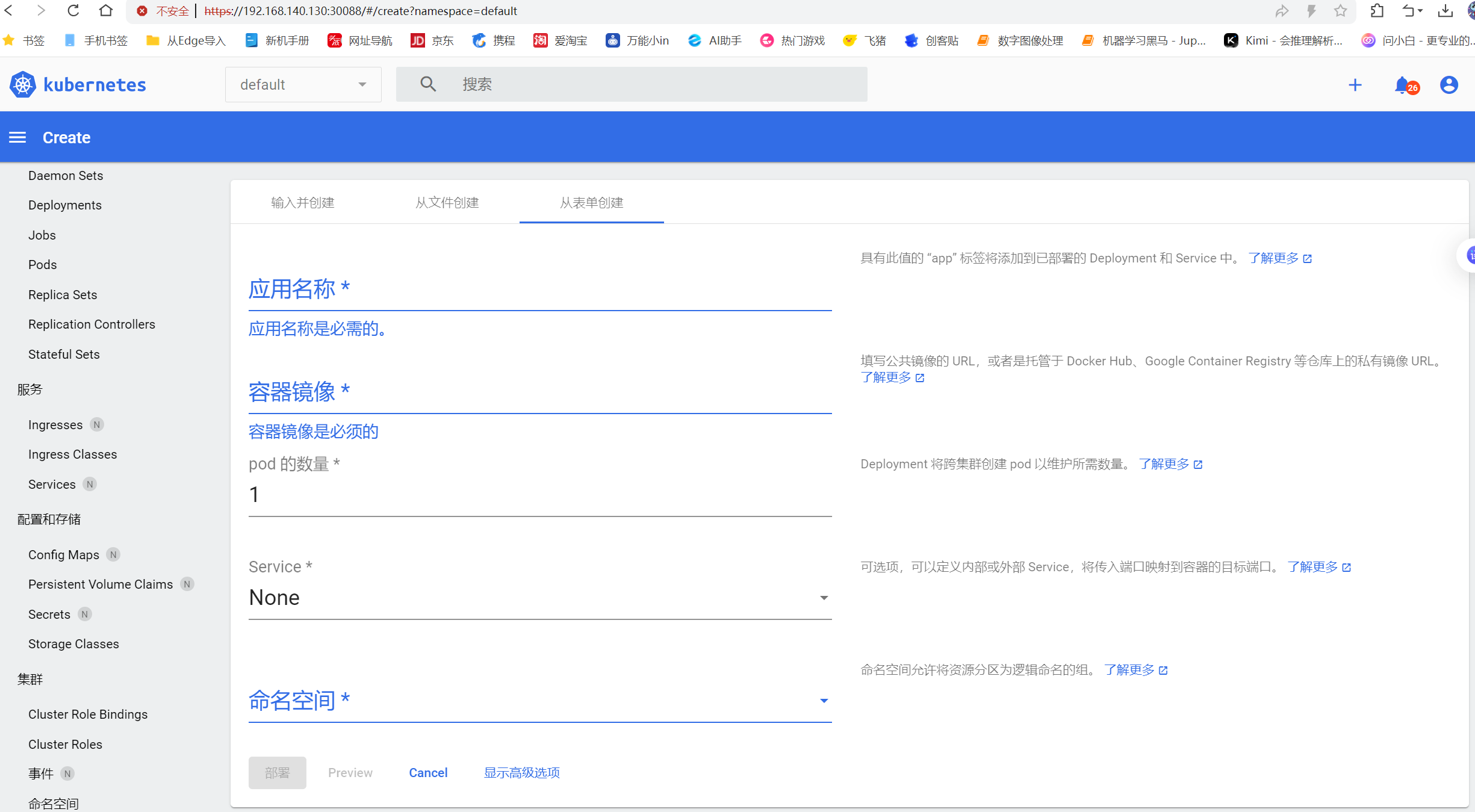
十一、安裝部署Prometheus+grafana
安裝Prometheus
[root@prometheus ~]# mkdir /prom
[root@prometheus ~]# cd /prom# 獲取Prometheus安裝包
[root@master prom]# wget https://github.com/prometheus/prometheus/releases/download/v2.43.0/prometheus-2.43.0.linux-amd64.tar.gz
[root@prometheus /prom]# ls
prometheus-2.43.0.linux-amd64.tar.gz# 解壓文件
[root@prometheus prom]# tar xf prometheus-2.43.0.linux-amd64.tar.gz
[root@prometheus prom]# ls
prometheus-2.43.0.linux-amd64 prometheus-2.43.0.linux-amd64.tar.gz[root@prometheus prom]# mv prometheus-2.43.0.linux-amd64 prometheus
[root@prometheus prom]# cd prometheus
[root@master prometheus]# ls
console_libraries consoles LICENSE NOTICE prometheus prometheus.yml promtool
# 修改PATH變量
[root@prometheus prometheus]# PATH=/prom/prometheus:$PATH
[root@prometheus prometheus]# vim /etc/profile
PATH=/prom/prometheus:$PATH # 加在最后
# 在后臺運行
[root@prometheus prometheus]# nohup prometheus --config.file=/prom/prometheus/prometheus.yml &# 查看Prometheus進程
[root@prometheus prometheus]# ps aux|grep prom
root 8197 1.4 2.1 798956 40900 pts/0 Sl 14:56 0:00 prometheus --config.file=/prom/prometheus/prometheus.yml
root 8204 0.0 0.0 112824 972 pts/0 S+ 14:56 0:00 grep --color=auto prom# 查看Prometheus端口
[root@prometheus prometheus]# netstat -anplut | grep prom
tcp6 0 0 :::9090 :::* LISTEN 8197/prometheus
tcp6 0 0 ::1:9090 ::1:41618 ESTABLISHED 8197/prometheus
tcp6 0 0 ::1:41618 ::1:9090 ESTABLISHED 8197/prometheus# 關閉防火墻
[root@prometheus prometheus]# service firewalld stop
Redirecting to /bin/systemctl stop firewalld.service
[root@prometheus prometheus]# systemctl disable firewalld
Removed symlink /etc/systemd/system/multi-user.target.wants/firewalld.service.
Removed symlink /etc/systemd/system/dbus-org.fedoraproject.FirewallD1.service.# 配置關于Prometheus服務的參數
[root@prometheus prometheus]# vim /usr/lib/systemd/system/prometheus.service
[Unit]
Description=Prometheus Monitoring System
Documentation=https://prometheus.io/docs/introduction/overview/[Service]
User=prometheus
Group=prometheus
ExecStart=/prom/prometheus/prometheus \--config.file=/prom/prometheus/prometheus.yml \--storage.tsdb.path=/prom/prometheus/data \--web.listen-address=0.0.0.0:9090
ExecReload=/bin/kill -HUP $MAINPID
KillMode=process
Restart=on-failure
RestartSec=30s[Install]
WantedBy=multi-user.target# 關閉selinux
[root@prometheus prometheus]# setenforce 0
[root@prometheus prometheus]# sed -i '/^SELINUX=/ s/enforcing/disabled/' /etc/selinux/config#創建專用用戶并設置權限
# 創建用戶(若不存在)
id prometheus || sudo useradd --no-create-home --shell /bin/false prometheus
# 重置權限
sudo mkdir -p /prom/prometheus/data
sudo chown -R prometheus:prometheus /prom/prometheus
sudo chmod -R 775 /prom/prometheus# 重新加載systemd的配置文件
[root@prometheus prometheus]# systemctl daemon-reload#徹底清理舊進程
[root@prometheus prometheus]# ps aux|grep prom
root 8734 0.0 2.6 930284 48580 pts/0 Sl 17:55 0:00 prometheus --config.file=/prom/prometheus/prometheus.yml
[root@prometheus prometheus]# kill -9 8734
[root@prometheus prometheus]# service prometheus restart
# 用瀏覽器訪問 IP:9090
在要被監聽的機器上安裝exporter
# 在被監聽的機器上操作,這里我們選擇master
[root@master ~]# tar xf node_exporter-1.4.0-rc.0.linux-amd64.tar.gz
[root@master ~]# mv node_exporter-1.4.0-rc.0.linux-amd64 /node_exporter
[root@master ~]# cd /node_exporter/
[root@master node_exporter]# ls
LICENSE node_exporter NOTICE# 修改環境變量
[root@master node_exporter]# PATH=/node_exporter/:$PATH
[root@master node_exporter]# vim /root/.bashrc
PATH=/node_exporter/:$PATH# 在后臺執行
[root@master node_exporter]# nohup node_exporter --web.listen-address 0.0.0.0:8090 &
[1] 4844
[root@master node_exporter]# nohup: 忽略輸入并把輸出追加到"nohup.out"# 檢查進程
[root@master node_exporter]# ps aux |grep node_exporter
root 84412 0.0 0.3 716544 13104 pts/0 Sl 15:51 0:00 node_exporter --web.listen-address 0.0.0.0:8090
root 84846 0.0 0.0 112824 980 pts/0 S+ 15:52 0:00 grep --color=auto node_exporter# 關閉防火墻
[root@prometheus /]# service firewalld stop
Redirecting to /bin/systemctl stop firewalld.service
[root@prometheus /]# systemctl disable firewalld#關閉selinux:
setenforce 0
sed -i '/^SELINUX=/ s/enforcing/disabled/' /etc/selinux/config瀏覽器訪問:ip+8090# 設置node_exporter開機啟動
[root@prometheus /]# vim /etc/rc.local
nohup /node_exporter/node_exporter --web.listen-address 0.0.0.0:8090 &
[root@prometheus node_exporter]# chmod +x /etc/rc.d/rc.local在Prometheus機器的/prom/prometheus/prometheus.yml 里添加機器- job_name: "prometheus"static_configs:- targets: ["localhost:9090"]- job_name: "master"static_configs:- targets: ["192.168.140.130:8090"]# 刷新Prometheus服務
[root@prometheus prometheus]# service prometheus restart
Redirecting to /bin/systemctl restart prometheus.service#訪問 Prometheus --》IP:9090 然后在“Status” -> “Targets”中查看 Node Exporter 是否被列為“UP”狀態
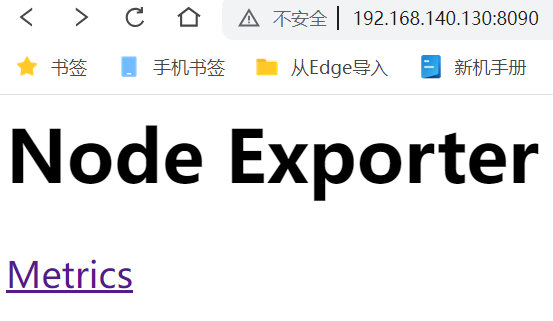
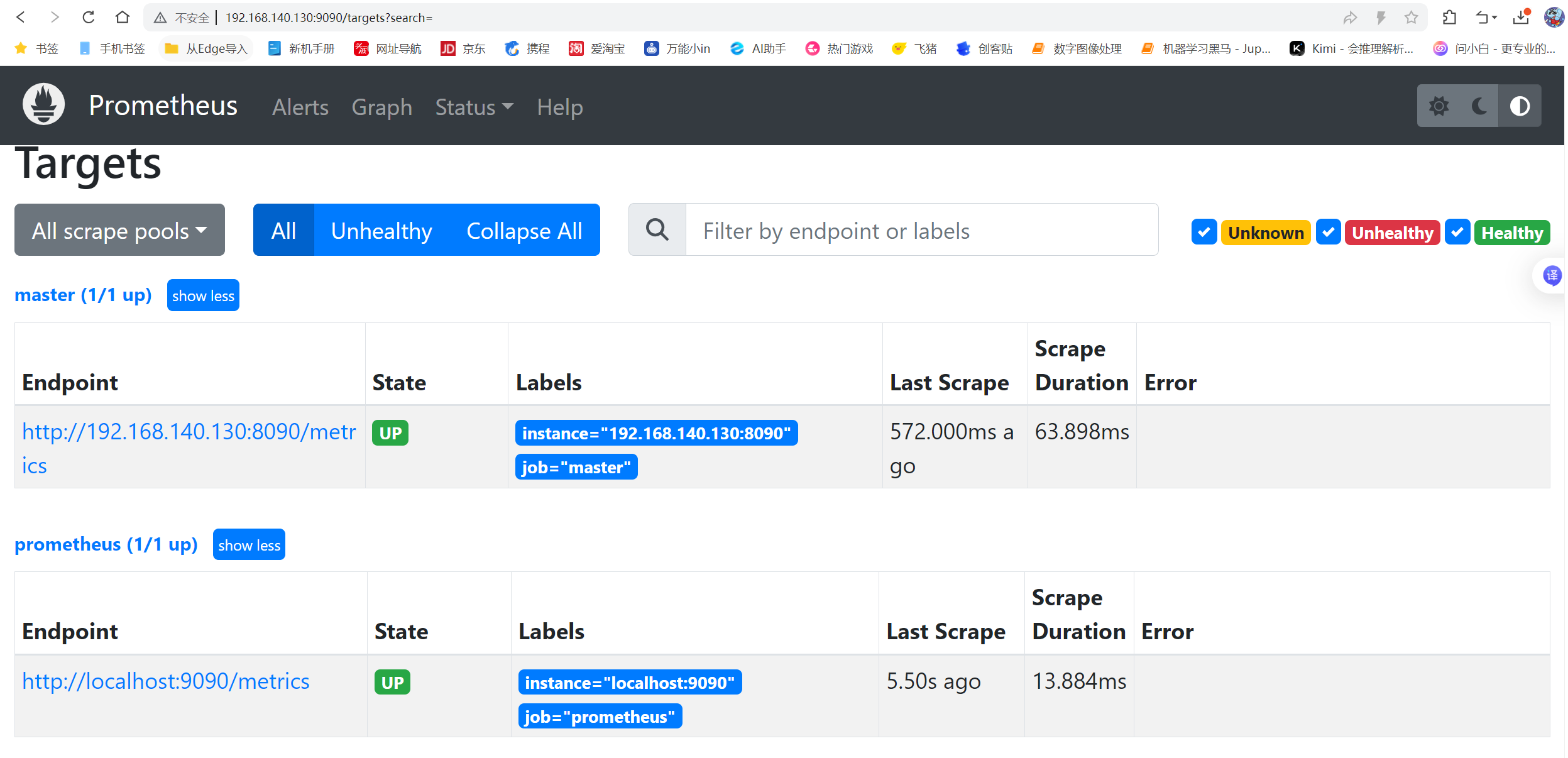
安裝部署Grafana
[root@prometheus ~]# ls
anaconda-ks.cfg grafana-enterprise-9.1.2-1.x86_64.rpm node_exporter-1.4.0-rc.0.linux-amd64.tar.gz[root@prometheus ~]# yum install grafana-enterprise-9.1.2-1.x86_64.rpm -y
啟動
[root@prometheus ~]# service grafana-server start
Starting grafana-server (via systemctl): [ 確定 ][root@prometheus ~]# ps aux|grep grafana
grafana 8230 6.6 3.8 1195912 71472 ? Ssl 16:48 0:00 /usr/sbin/grafana-server --config=/etc/grafana/grafana.ini --pidfile=/var/run/grafana/grafana-server.pid --packaging=rpm cfg:default.paths.logs=/var/log/grafana cfg:default.paths.data=/var/lib/grafana cfg:default.paths.plugins=/var/lib/grafana/plugins cfg:default.paths.provisioning=/etc/grafana/provisioning
root 8238 0.0 0.0 112824 976 pts/0 R+ 16:49 0:00 grep --color=auto grafana[root@prometheus ~]# netstat -anplut|grep grafana
tcp 0 0 192.168.121.108:44674 34.120.177.193:443 ESTABLISHED 8230/grafana-server
tcp6 0 0 :::3000 :::* LISTEN 8230/grafana-server# 瀏覽器訪問 ip:3000
默認用戶名:admin
默認密碼:adminConfiguration --> Add data source -> 選擇Prometheus
填 http://192.168.140.130:9090
dashboard -> import -> 添加模板 1860 -> 選擇Prometheus數據源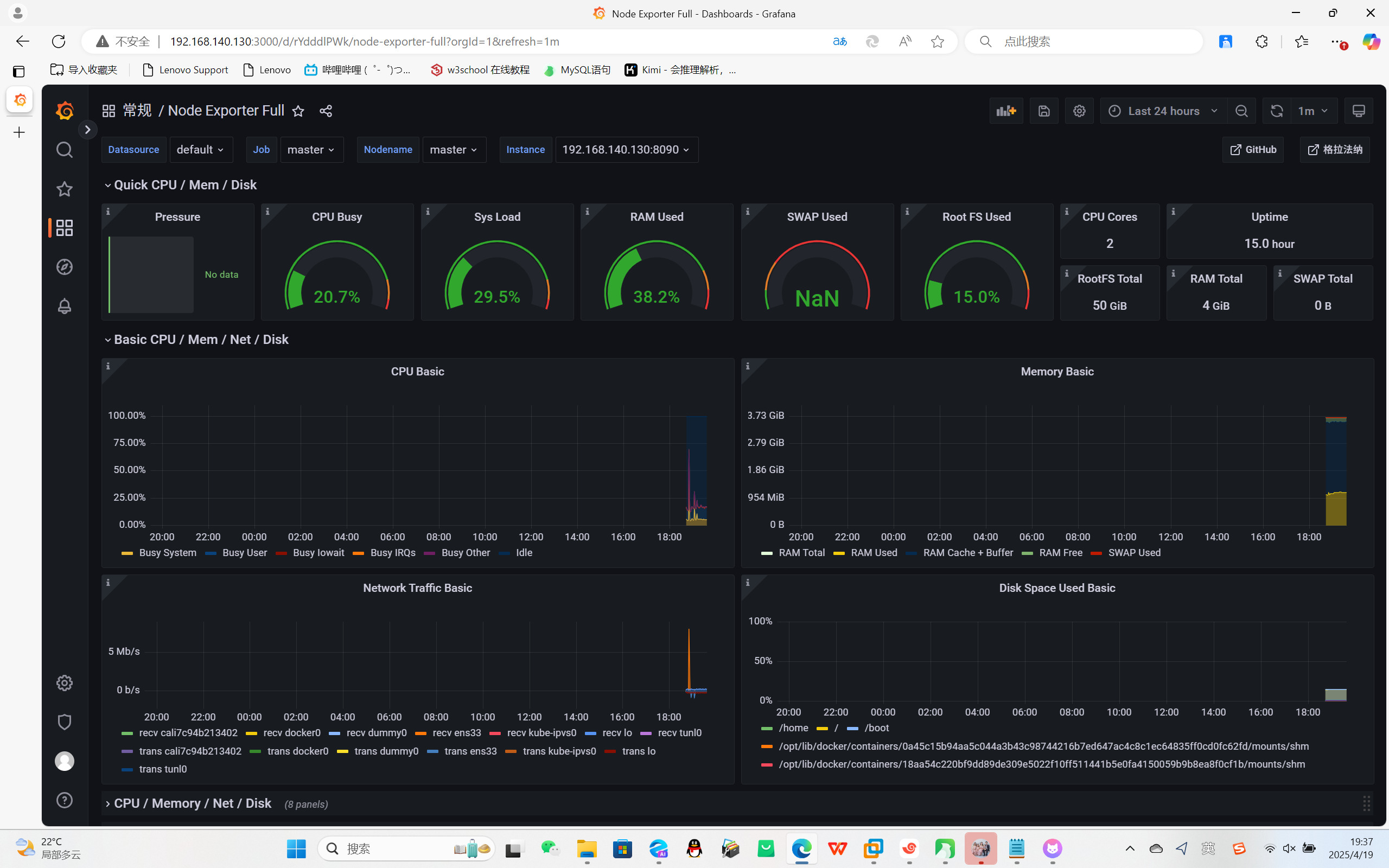


- 豆瓣圖書數據清洗與處理)








![[RHEL8] 指定rpm軟件包的更高版本模塊流](http://pic.xiahunao.cn/[RHEL8] 指定rpm軟件包的更高版本模塊流)







